EDITOR’S NOTE: Please be advised that this San Sebastian travel guide hasn’t been updated in 2025. Prices and travel guidelines may no longer be accurate so it’s important that you verify any information before proceeding.
San Sebastian (or Donostia to the Basque) is one of the most popular tourist destinations in Spain. It’s got beautiful churches and buildings and a wide sandy beach described as one of the best in-city beaches in Europe.
But what San Sebastian is most famous for, is its food. It’s renowned for its Basque cuisine and boasts the second most Michelin stars per capita in the world, behind only Kyoto. Home to the humble pintxo, it’s considered by many to be the greatest gastronomic destination in Spain.
Food is why we visited San Sebastian but there’s plenty to love about this alluring city often referred to as the “Pearl of the Cantabrian Sea”.
VISIT SAN SEBASTIAN QUICK LINKS
This travel guide to San Sebastian is long. For your convenience, I’ve compiled links to hotels, tours, and other services here.
HOTELS
Top-rated hotels in the Parte Viaje, the best area to stay for first-time visitors to Donostia.
- Luxury: Lasala Plaza Hotel
- Midrange: Ur-Alde
- Budget: Pensión San Telmo / San Juan
TOURS
- Sightseeing Tour: 2-Hour Walking Tour with Pintxo and Drink
- Food Tour: Gourmet Pintxo Tour
OTHER SERVICES
- Visa Services
- Travel Insurance with COVID cover (WFFF readers get 5% off)
- Car Rental
- Spain eSIM
Save This on Pinterest!
No time to read this San Sebastian travel guide now? Click on the save button and pin it for later!
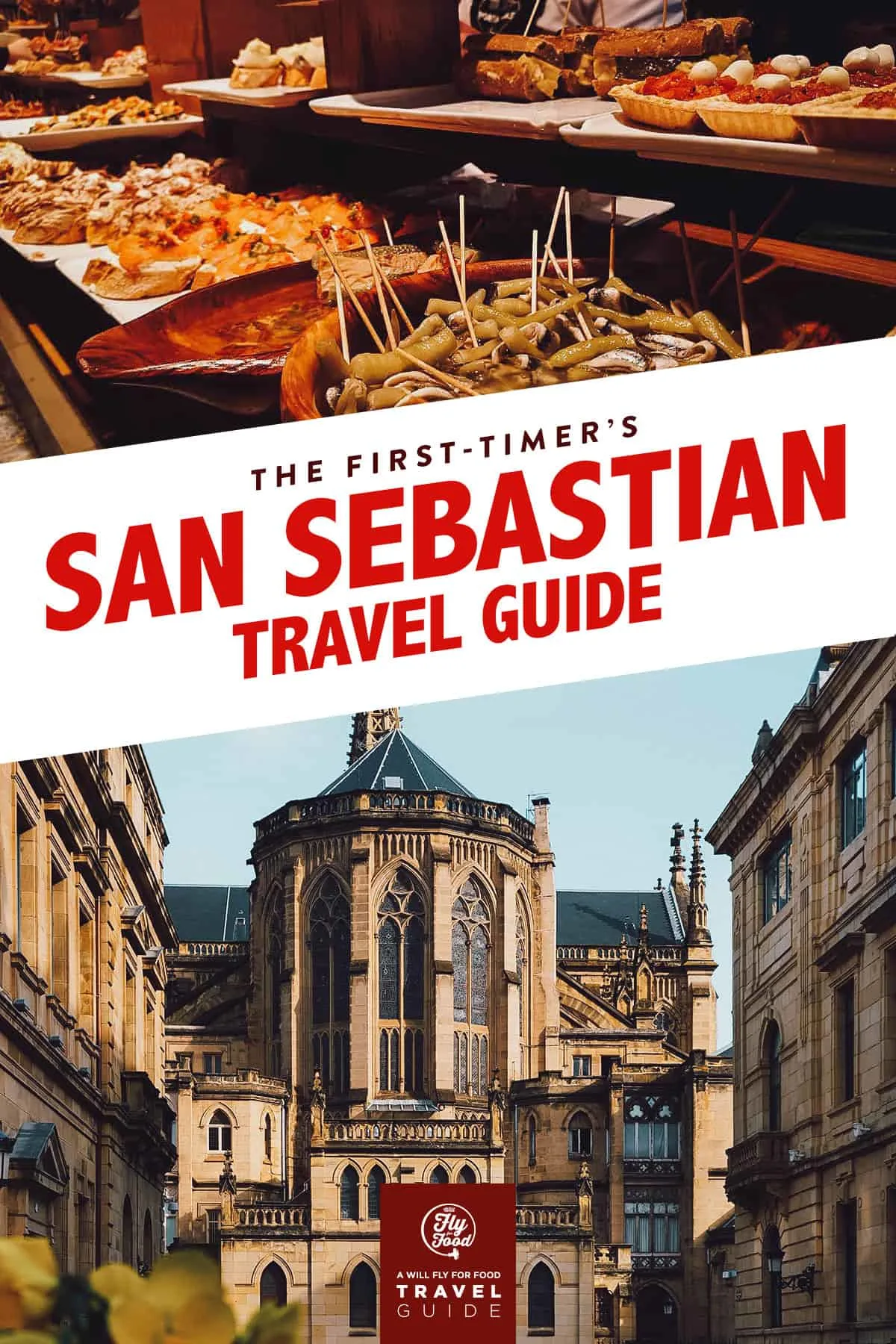
GUIDE TABLE OF CONTENTS
SAN SEBASTIAN TRAVEL RESTRICTIONS
Because of the current global situation, San Sebastian travel guidelines have been changing on a regular basis. Our friends at Booking.com created a website that lists detailed information on travel restrictions around the globe.
Before planning a trip to San Sebastian, be sure to check Booking.com for information on travel restrictions to Spain. If you do decide to visit San Sebastian, then you may want to seriously consider getting travel insurance with COVID coverage.
SPAIN VISA
You may need a visa and other documents to travel to Spain depending on what passport you carry. Visit iVisa.com to learn about the requirements and to apply for a visa (if necessary).
DONOSTIA-SAN SEBASTIAN AT A GLANCE
San Sebastian is a coastal city in the Basque Country in northern Spain. The capital of Gipuzkoa province, it’s referred to as Donostia in the Basque language and officially known as Donsotia-San Sebastian.
San Sebastian is one of the most visited cities in Spain and famous for its beaches and world-renowned cuisine. It offers an exciting range of culinary experiences from pintxos to txokos to sidrerias (cider houses) and Michelin-starred restaurants.
According to the 2020 Spain and Portugal Michelin Guide, San Sebastian has a total of ten Michelin stars shared by six restaurants. Two of those restaurants – Arzak and Akelarre – have three Michelin stars apiece.
San Sebastian is comprised of multiple districts but first-time visitors will be spending most of their time in the Parte Vieja or the Old Town. It’s the historical core of the city known for its labyrinth of churches, pintxos bars, and buildings dating back to the early 19th century.
BEST TIME TO VISIT SAN SEBASTIAN
In terms of the weather, May till July is an ideal time to visit San Sebastian. Temperatures are mild and it’s one of the driest times of the year. Peak tourist season is getting underway but it won’t be as bad as August or September.
We were in San Sebastian in early May. Some of the most popular pintxos bars would get pretty crowded but it was never unbearable.
MAY-JUL: As described, May till July is one of the best times to visit San Sebastian. June and July will have better beach weather than May, but the city will also see an influx of domestic tourists looking to escape the summer heat. If you’re going mainly for the pintxos, then it’s better to visit in May which is also the tail end of the cider season.
AUG-SEP: These are peak months in San Sebastian and the busiest time to be in the city. August has the most ideal beach weather while September hosts the annual San Sebastian Film Festival. If you aren’t interested in either, then it’s best to avoid these months.
OCT-APR: These are the coldest and rainiest months in San Sebastian. With that said, the coldest it gets is around 5-6°C (41-42°F) which isn’t unbearable. If you don’t mind the weather, then this isn’t a bad time to go as hotel prices will be at their lowest. January till April is also peak cider season making it an excellent time to visit for food and wine lovers.
Climate: Annual Monthly Weather in San Sebastian
Check out these climate graphs for more on San Sebastian’s weather. I’ve also created the average temperature and annual rainfall graphs below with the most ideal months to visit highlighted in orange.
Average Temperature
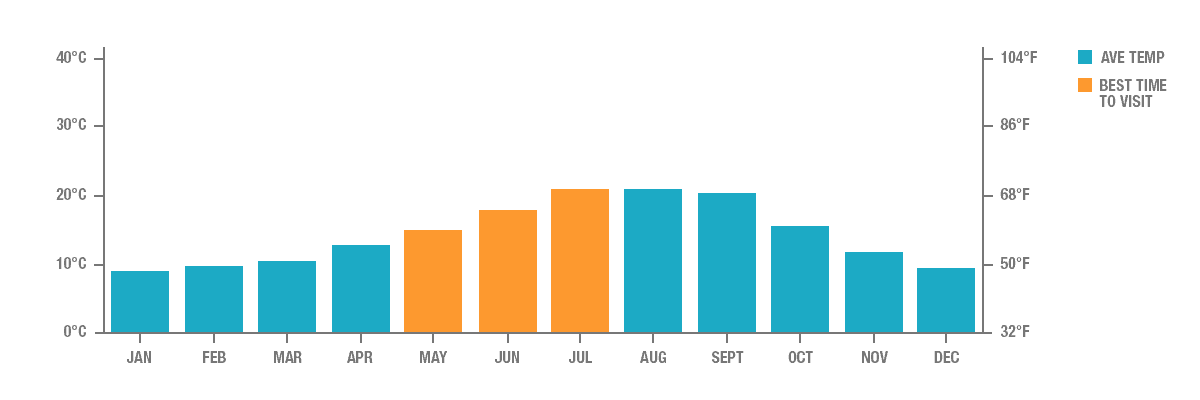
Annual Rainfall
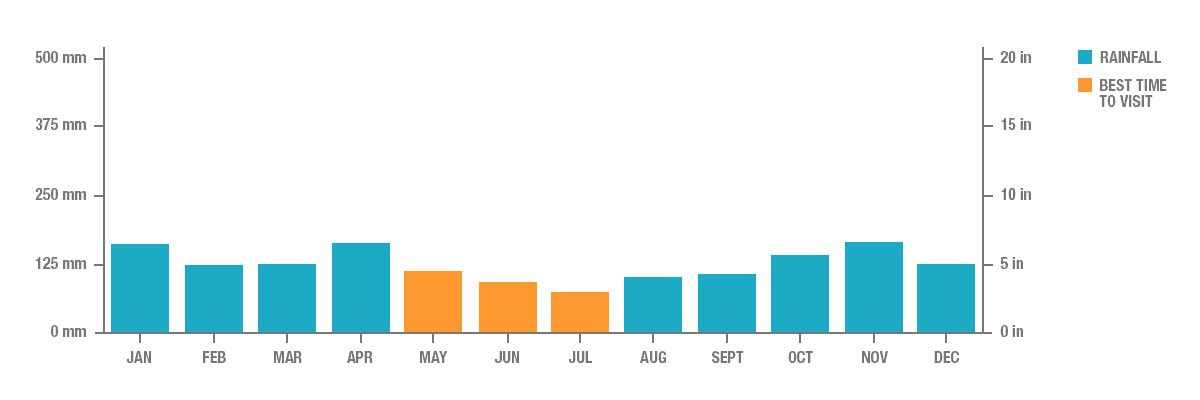
TRAVELING TO SAN SEBASTIAN
We arrived in San Sebastian by overnight bus from Madrid but there are plenty of ways to get there depending on where you are. I’ll describe each method below but you can also refer to the Donostia-San Sebastian tourism website for more information.
By Plane
There are three airports near San Sebastian – San Sebastian Airport (EAS), Biarritz Airport (BIQ), and Bilbao Airport (BIO). Described below are the ways you can get to San Sebastian from either of these three airports.
San Sebastian Airport (EAS)
This is San Sebastian’s domestic airport and the closest to the city. If you’re flying to San Sebastian from a major Spanish city like Madrid or Barcelona, then chances are you’ll be flying into this airport.
Bus E21 will take you to Plaza de Gipuzkoa in San Sebastian in about 40 minutes. If you’d rather not ride the bus, then you can take a taxi or book a private transfer. It’s faster and more comfortable but also more expensive.
Biarritz Airport (BIQ)
Biarritz Airport is located across the border in the French Basque Country about 47 km (29.2 miles) northeast of San Sebastian. French airlines and international low cost carriers operate flights to and from Biarritz Airport.
You can catch an Alsa bus from Biarritz Airport to San Sebastian. Travel time is about 45 minutes. Alternatively, you can also use the French long-distance carpooling service called BlaBlaCar.
Bilbao Airport (BIO)
Bilbao Airport is the largest airport in the Basque Country. It’s about 100 km (62.1 miles) west of San Sebastian.
There are a few ways to get from Bilbao Airport to San Sebastian but the quickest and most convenient is by direct Pesa bus. Travel time is around 1 hr 15 mins.
Alternatively, you can take a taxi or book a private transfer from Bilbao Airport to your hotel in San Sebastian.
By Train
Spain’s railway network is extensive and efficient and a great way to explore the country. If you’re in a city relatively near San Sebastian, then it’s perhaps a more convenient option than flying. You can check for routes to San Sebastian and buy tickets on Trainline.
By Bus
As described, we took a 6-hr overnight bus from Madrid to San Sebastian. Buses are cheaper than trains and perhaps the most economical way of getting around Spain.
We took two long-haul buses in Spain, from Granada to Madrid then Madrid to San Sebastian and both were very comfortable. You can book bus tickets to San Sebastian on Bookaway.
By Car
Renting a car and driving yourself is perhaps the best way of exploring Spain and Europe. We drove from San Sebastian to Santiago de Compostela and it turned out to be one of the most fun legs of our trip. You can rent a car in Spain through Rentalcars.com.
WHERE TO EXCHANGE CURRENCY
The unit of currency in Spain is the Euro (EUR).
I withdrew EUR from an ATM so I didn’t have to exchange currency in San Sebastian. This seems to be the best option in Spain and in many other European countries these days.
If you plan on using your ATM card in Spain, then it’s best to let your bank know before your trip. That way they don’t flag any transactions in Europe. My ATM card works in most machines but not all. I didn’t have any problems in Spain.
NOTE: Some ATMs may ask if you’d like to proceed “with or without conversion”. Always proceed WITHOUT conversion. Proceeding with conversion authorizes the foreign bank operating the ATM to do the conversion for you, often at terrible exchange rates.
BEST AREAS TO STAY IN SAN SEBASTIAN
If it’s your first time visiting San Sebastian, then the Parte Vieja or the Old Town is the best place to stay. It’ll give you easy access to the city’s top tourist attractions and many of its best pintxos bars.
Listed below are some of the most convenient areas to stay in San Sebastian, along with a color-coded map to help you understand where each of these areas are. Click on the link for a live version of the map. (Please note that marked areas are approximations only)
RED – Parte Vieja (Old Town)
BLUE – Centro
PURPLE – La Concha Beach
ORANGE – Antiguo
GREEN – Gros
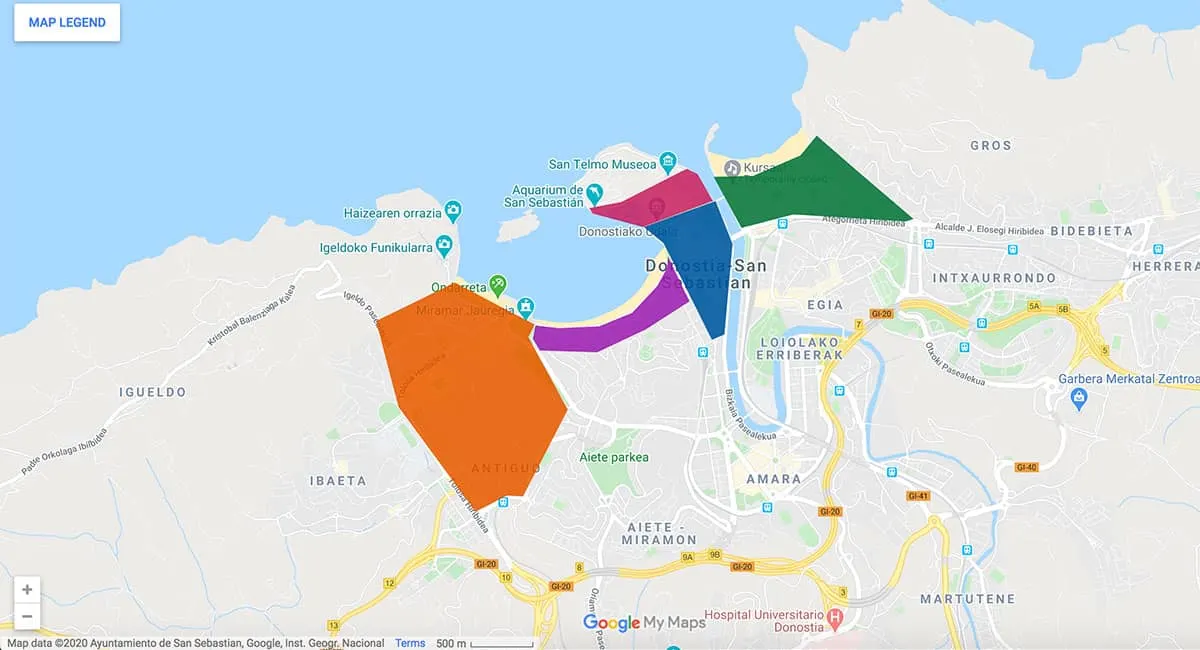
PARTE VIEJA
First-time visitors will be spending most of their time in the Old Town. It’s the historical and cultural heart of San Sebastian and its most iconic district.
As described, staying in the Parte Viaje will put you close to the city’s top tourist attractions like Mount Urgull, San Telmo Museum, and La Concha Beach, not to mention its many pintxos bars.
We stayed at Central Rooms, a lovely boutique hotel at Plaza de la Constitucion. Every time we walked out of the hotel, we found ourselves in the middle of the square filled with tables and diners enjoying drinks and food. It’s a great atmosphere.
You can book a room at Central Roomss on Agoda. If you don’t feel that this is the right place for you, then you can search for alternate listings on Booking.com or Agoda. Check out these top-rated hotels in the Parte Vieja:
- Luxury: Lasala Plaza Hotel
- Midrange: Ur-Alde
- Budget: Pensión San Telmo / San Juan
CENTRO
Centro refers to the area directly south of the Parte Vieja. Convenience-wise, it’s just as good as the Old Town if not better. It doesn’t get as busy as the Old Town and it puts you even closer to La Concha Beach. It’s also home to a few of the city’s most noteworthy landmarks like the cathedral, city hall, and the Victor Eugenia Theater.
If you can’t find a good hotel in the Parte Viaje, then the Central district will be just fine. You can search for accommodations in Centro on Booking.com or Agoda. Check out some of the top-rated hotel in the area:
- Luxury: Hotel Maria Cristina, a Luxury Collection Hotel, San Sebastian
- Midrange: Legazpi Doce Rooms
- Budget: Pensión Donostiarra
LA CONCHA BEACH
If you love sand and surf, then near La Concha Beach is probably where you’ll want to be. La Conch Beach is regarded as one of the best in-city beaches not just in Spain, but in all of Europe.
You can search for accommodations near La Concha Beach on Booking.com. If it’s your first time in San Sebastian, then I suggest staying towards the eastern half of the beach so you don’t have to walk too far to get to the Old Town. Check out some of the top-rated hotels near La Concha Beach:
- Luxury: Hotel Boutique Villa Favorita
- Midrange: Hotel Niza
- Budget: La Concha Bay Guesthouse
ANTIGUO
Antiguo is the neighborhood on the western side of La Concha Beach. It’s a trendier area that’s home to a few noteworthy attractions like Miramar Palace, Mount Igueldo, and the Comb of the Wind.
Antiguo and the Parte Vieja are separated by about 1.5 km (1 mile) of beach. It’s a beautiful seaside walk so if you don’t mind the distance, then this could be a great place to stay. You can search for accommodations in Antiguo on Booking.com or Agoda. Check out some of the top-rated hotels in the area:
- Luxury: San Sebastian-Antiguo
- Midrange: Hotel Distrito Oeste
- Budget: Olarain
GROS
Located east of the Parte Vieja, Gros is described as a great place to stay for surfers, backpackers, and people looking for more nightlife options in San Sebastian. It’s less expensive than the Old Town and home to Zurriola Beach which is said to have the best surfing in the city.
Located across the Puente Del Kursaal Bridge, Gros is a bit closer to the Old Town and may be a more convenient option for first-timers than Antiguo. You can search for accommodations in Gros on Booking.com or Agoda. Check out some of the top-rated hotels in the area:
- Luxury: Bidaia Boutique Hotel
- Midrange: Hotel Trueba
- Budget: Pensión Aia
You can also book hotels and home stays in San Sebastian using the handy map below.
PLACES TO VISIT IN SAN SEBASTIAN
The top tourist attractions in San Sebastian are clustered within a relatively small area so they’re easy to explore on your own. But if you’d prefer to go with a guide who can explain everything to you, then you can book a tour through Get Your Guide.
1. Good Shepherd Cathedral of San Sebastian
San Sebastian Cathedral (or Cathedral of the Good Shepherd) is the most impressive church in San Sebastian. Built in the late 19th century, it’s located in the Centro district and serves as the seat of the Diocese of San Sebastian.
The cathedral is about a 5-minute walk from the bus station so it was the first building I went to after arriving in San Sebastian. Like many churches in Spain, it’s a beautiful cathedral and one of the most well-known symbols of the city.
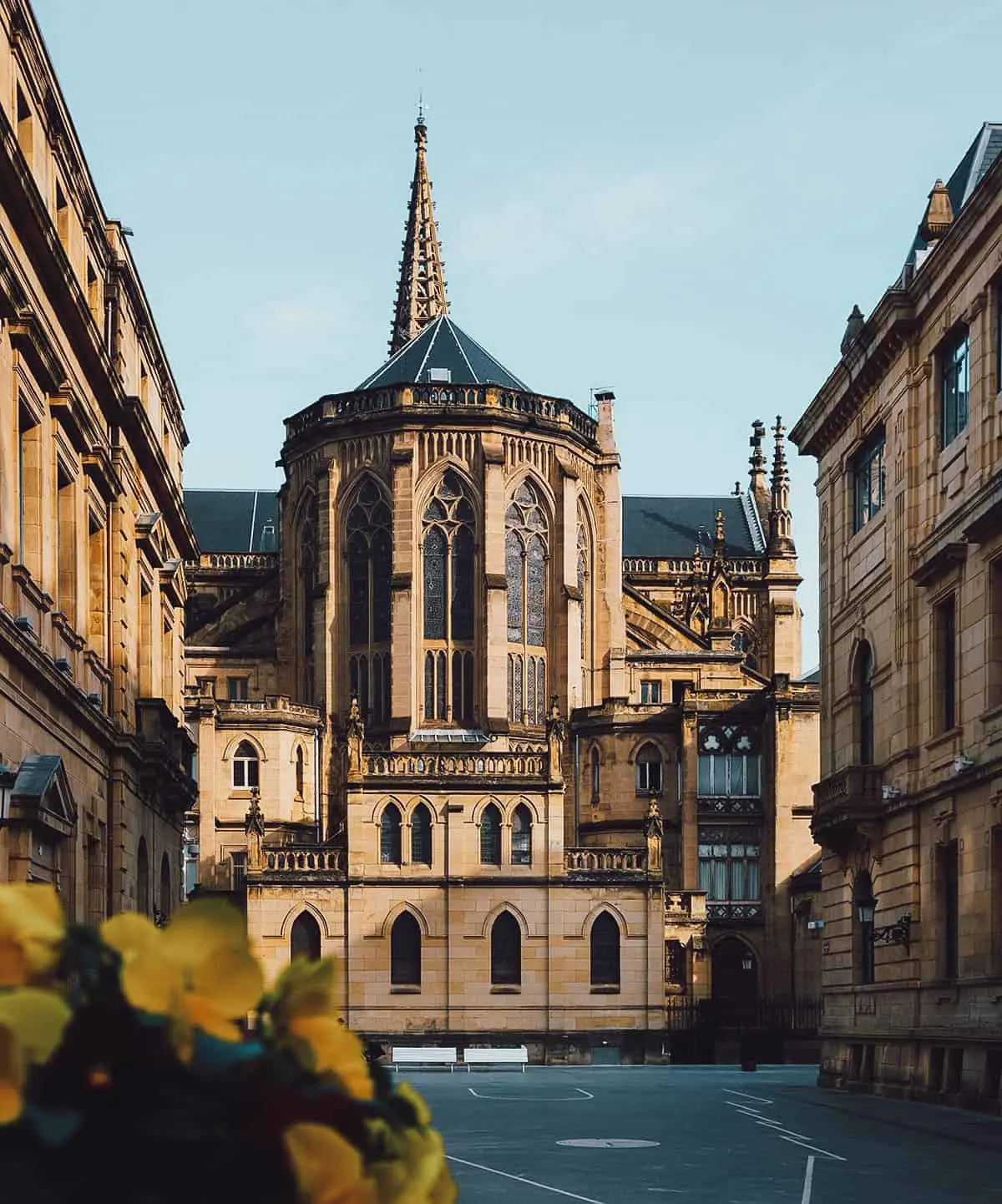
Photo by Iakov Filimonov via Shutterstock
2. San Telmo Museum
San Telmo Museum (STM) is one of the biggest and most interesting museums in San Sebastian. Opened in 1902, it’s the oldest museum in the Basque Country and features exhibits on Basque history from prehistoric to modern times.
Located at the foot of Mount Urgull, the museum is comprised of two contrasting structures – the original building dating back to the 16th century and a much newer wing built in 2011. It’s the most modern-looking building in the Parte Vieja and a good place to spend a couple of hours.
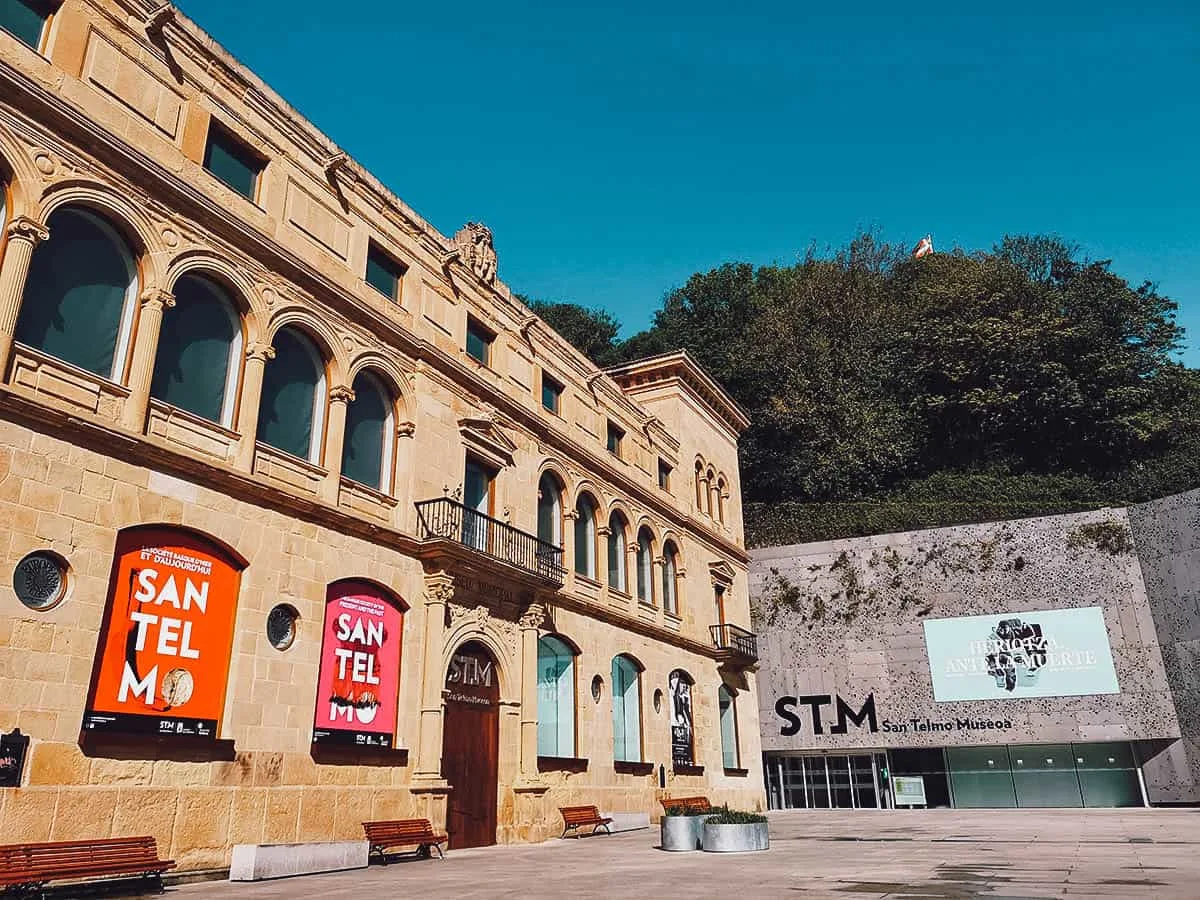
Operating Hours: 10AM-8PM, Tue-Sun (closed Mondays)
Admission: EUR 6
3. San Sebastian City Hall
Like the cathedral, San Sebastian City Hall is one of the most beautiful buildings in the city. It’s located inside a former casino that was closed after a countrywide ban on gambling in 1924.
I’m not sure if you can go inside but the city hall is located in the Centro district near La Concha Beach. I didn’t go close enough to notice but on the exterior walls of the building are bullet holes from the Spanish Civil War.
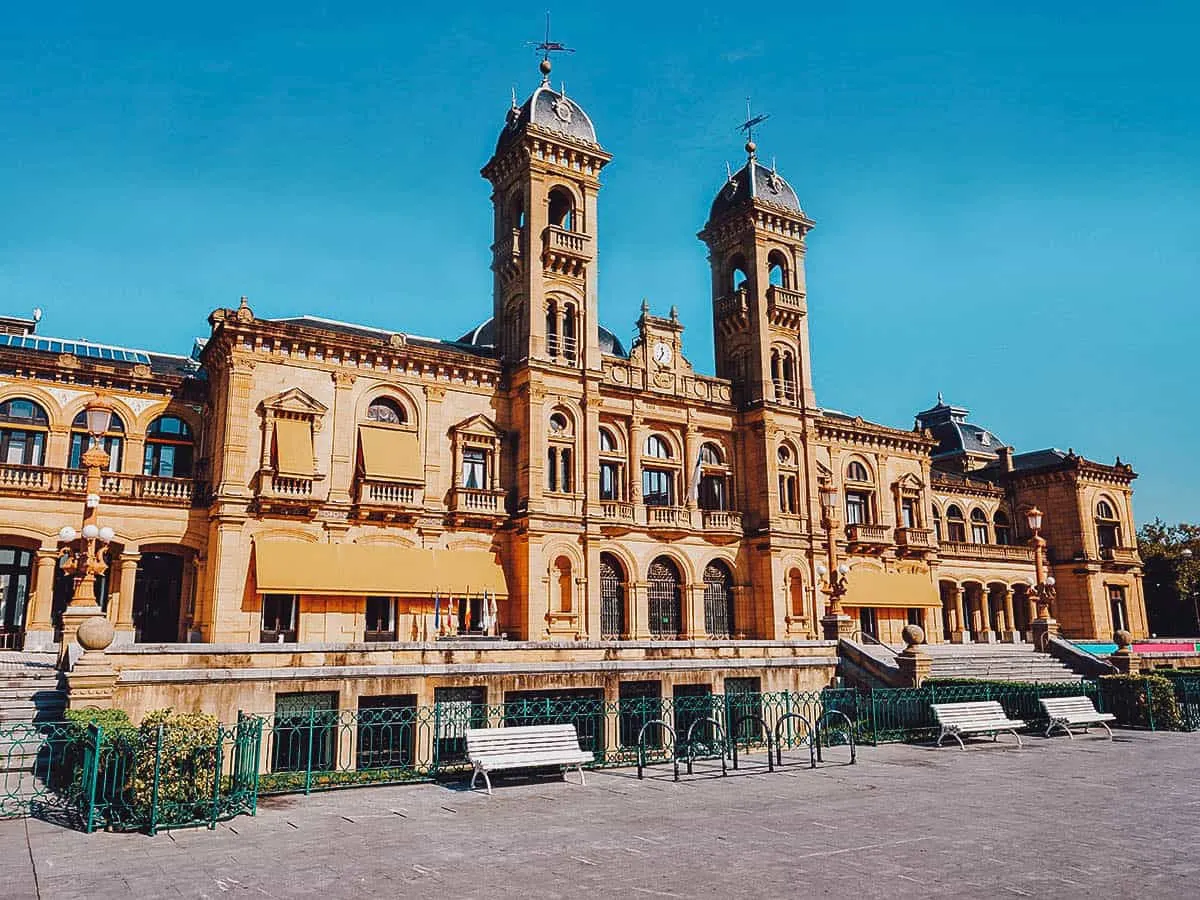
Photo by saiko3p via Shutterstock
4. San Sebastian Aquarium
If you enjoy aquariums, then you’ll probably want to visit the San Sebastian Aquarium. It’s home to over 30 exhibits with more than 200 species of marine animals like sharks, turtles, jellyfish, and stingrays.
Highlights include a 360° underwater tunnel and a museum section with fossils and exhibits detailing the maritime history of San Sebastian. The aquarium is located in the harbor at the foot of Mount Urgull, on the western side of the Parte Vieja.
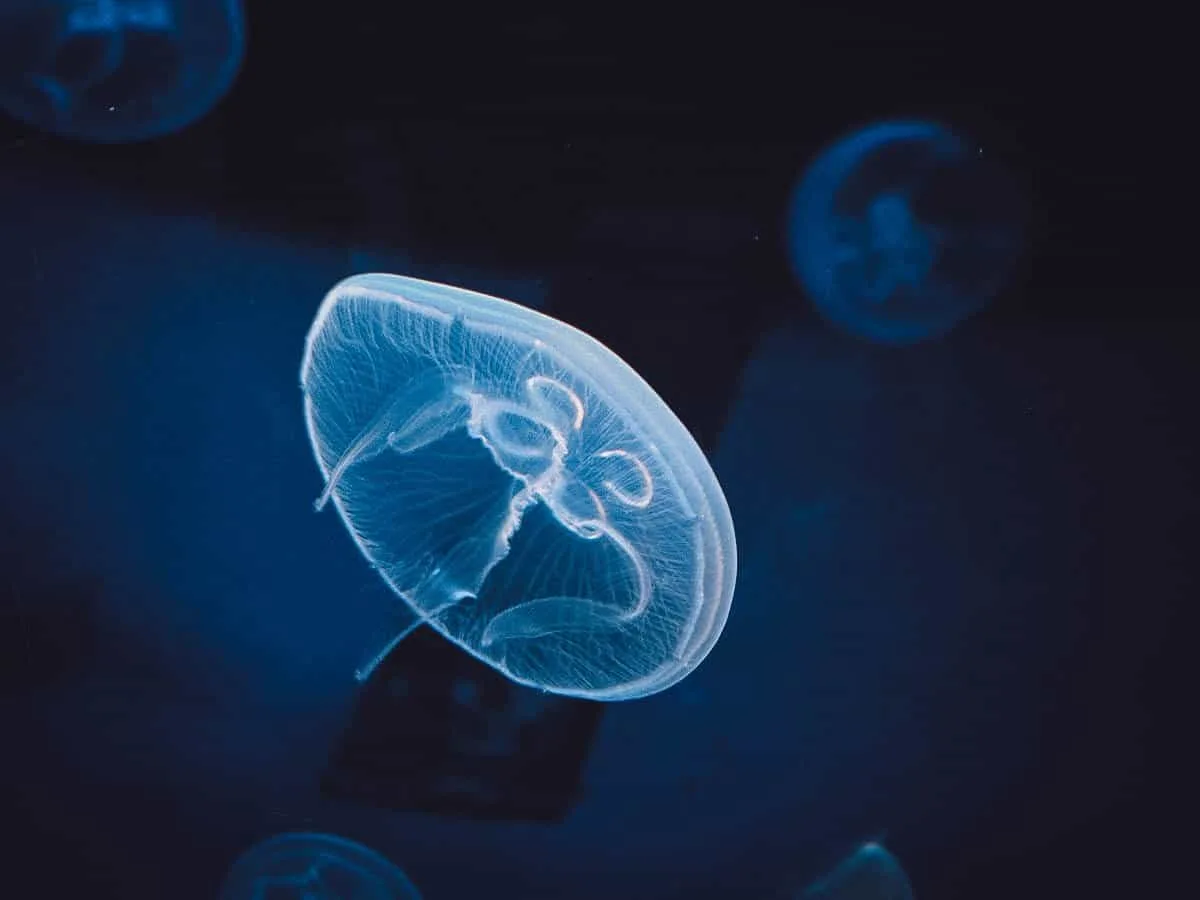
“IMG_0928” by Gael Chardon, used under CC BY-SA 2.0 / Processed in Photoshop and Lightroom
Operating Hours: 11AM-7PM, Tue-Sun (closed Mondays)
Admission: EUR 14 (adults), EUR 7 (kids)
5. Miramar Palace
Miramar Palace is a 19th century palace situated between La Concha and Ondarreta beaches. It served as the former summer residence of the Spanish monarchy.
The palace is lovely but the real draw are the parks and grassy lawns that offer spectacular views of the ocean. It’s a great place to sit and while away the time.
From the Old Town, you can walk along La Concha Beach to visit Miramar Palace.
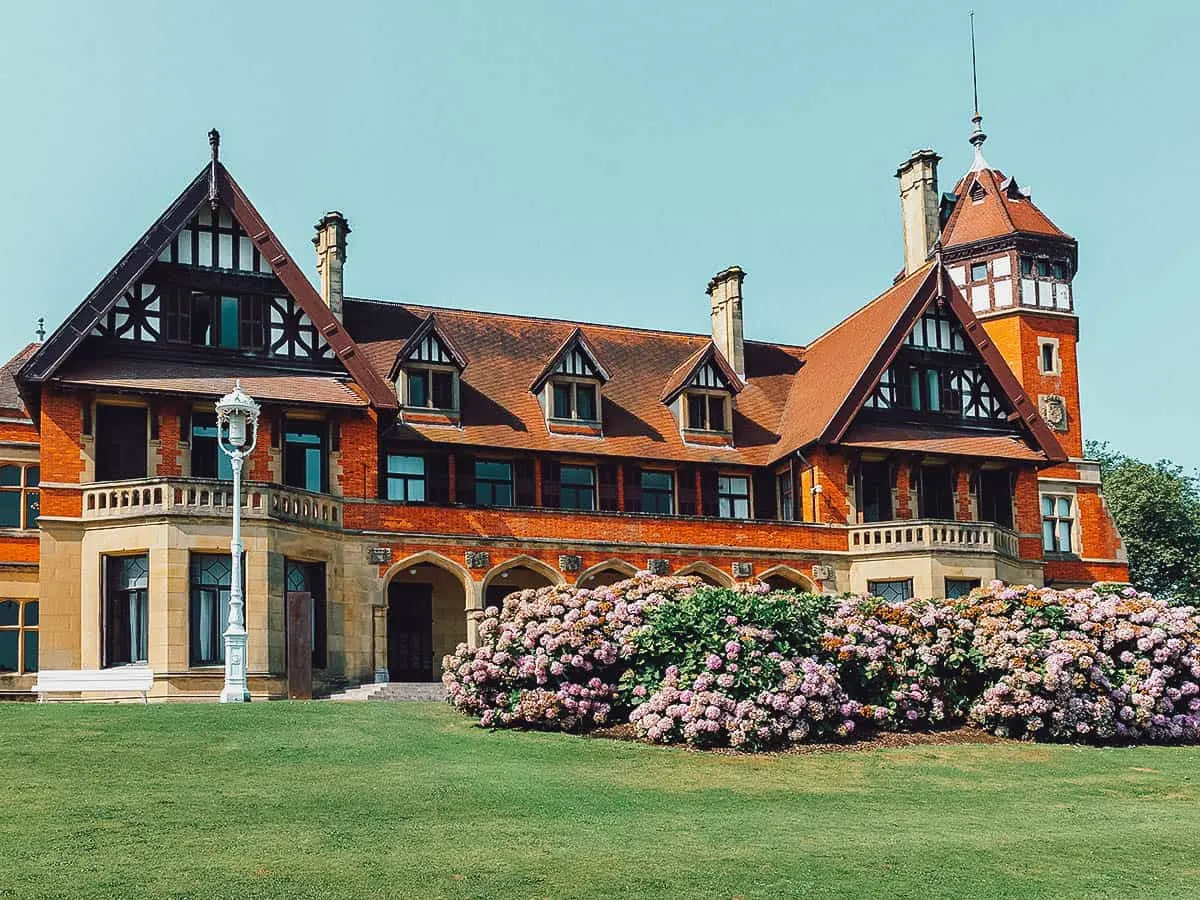
Photo by Noradoa via Shutterstock
Operating Hours: 7AM-9PM, daily
Admission: FREE
6. Comb of the Wind
The Comb of the Wind (Haizeen orrazia) is an interesting trio of sculptures by Basque sculptor Eduardo Chillida. It was done in collaboration with architect Luis Peña Ganchegui and features three large anchor-like sculptures embedded into rocks. Made of iron, each sculpture weighs over ten tons.
The sculptures are located at the foot of Mount Igueldo, on the western side of Ondarreta Beach. On turbulent days, waves crash into the sculptures and force seawater to gush out through blowholes in the observation deck’s floor.
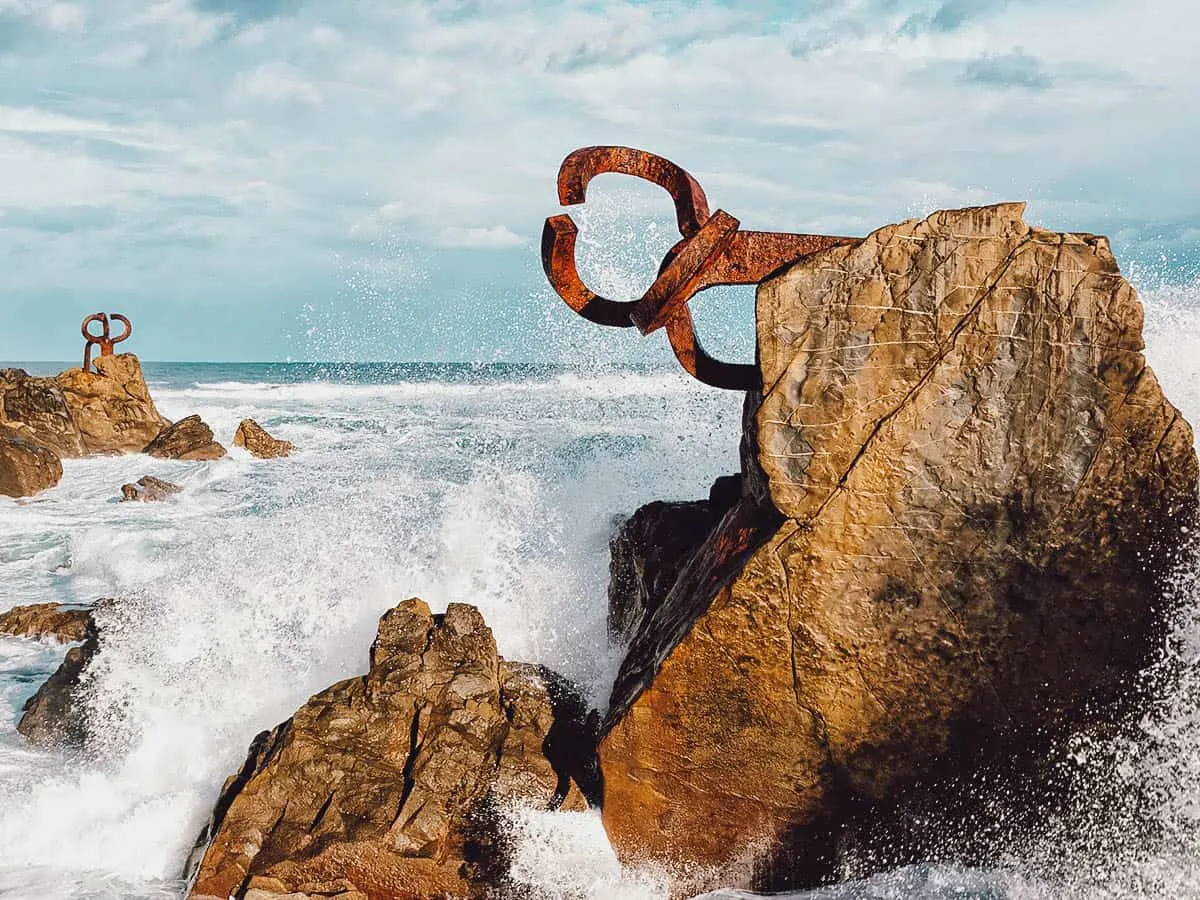
“The comb of the wind” by Miguel Mendez, used under CC BY 2.0 / Cropped, processed in Photoshop and Lightroom
THINGS TO DO IN SAN SEBASTIAN
1. Explore the Old Town (Parte Vieja)
First-time visitors will be spending most of their time in the Parte Vieja. It’s a charming labyrinth of historical buildings, churches, restaurants, and pintxos bars.
Pictured below is the Plaza de la Constitucion. It’s the Old Town’s main square and the former site of a bull fighting ring. The balconies overlooking the square were once rented out to spectators but many of them have now been converted into boutique hotels. Our hotel – Central Roomss – is located here.
This picture was taken early in the morning but the square is usually filled with people eating and drinking on al fresco dining tables.
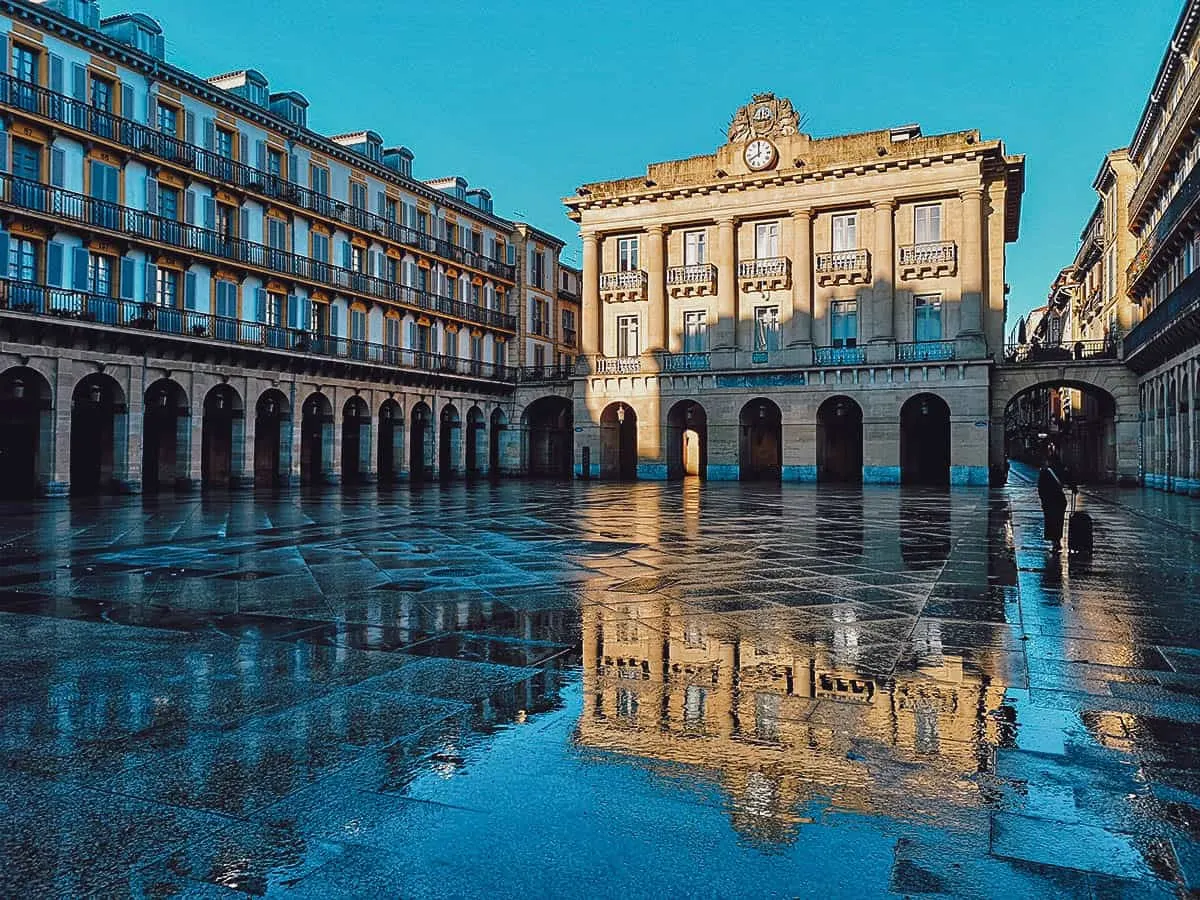
Turn a corner in the Old Town and you could find yourself looking up at a magnificent church like this one. The Basilica de Santa Maria del Coro is a baroque Roman Catholic church dating back to 1774.
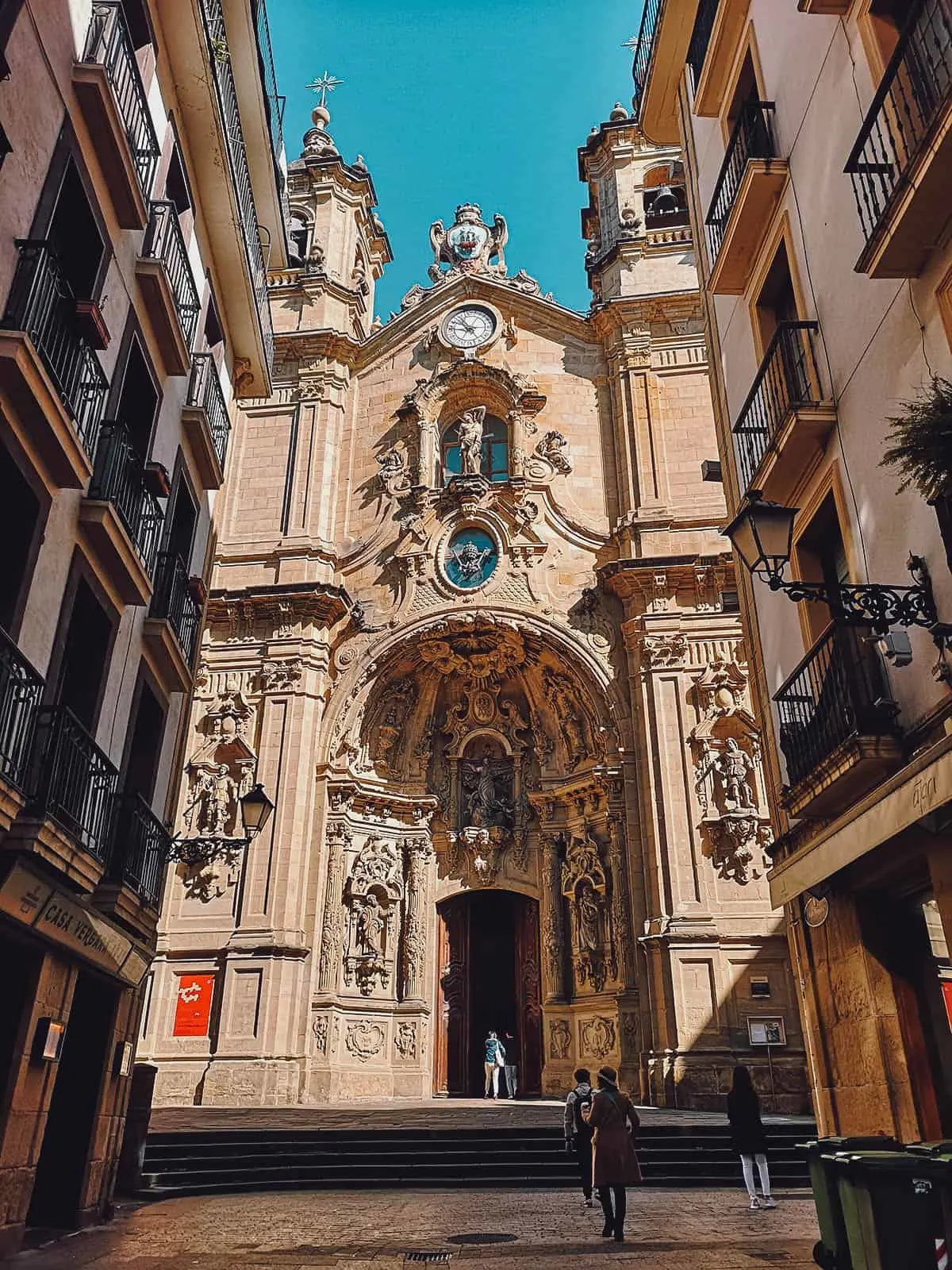
Not to be outdone, the Iglesia de San Vicente is just as striking and is thought to be the oldest building in San Sebastian. It dates back to the 12th century though its current gothic form was rebuilt in the early 1500s.
These churches are just two of the many fascinating buildings you’ll find in the Old Town.
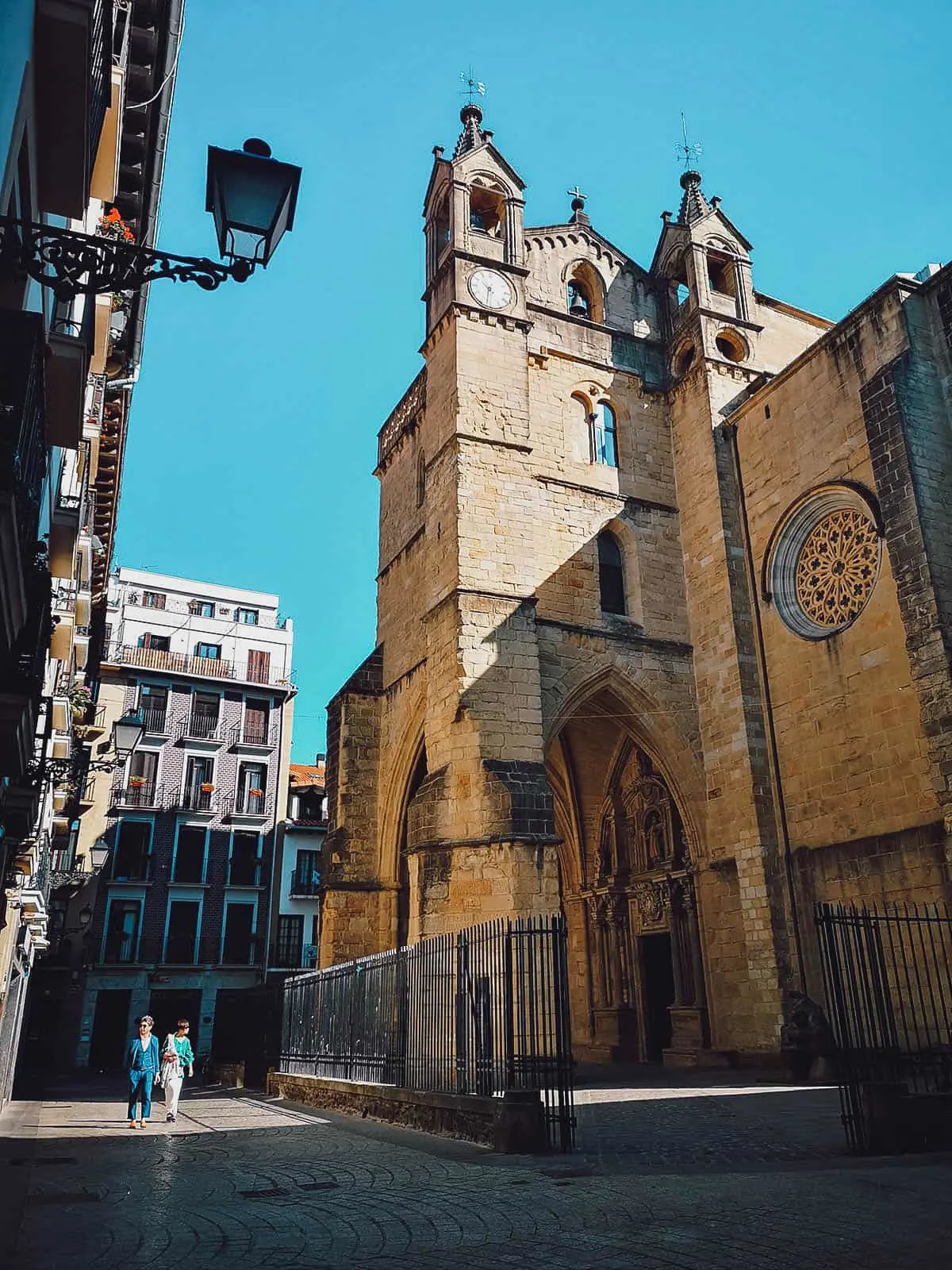
2. Take a Stroll on La Concha Beach
La Concha Beach is the biggest and most famous of San Sebastian’s three beaches. It’s a crescent, shell-shaped beach (hence the name) that’s considered one of the most beautiful in-city beaches in Europe. It’s perhaps the second biggest draw in San Sebastian, after pintxos.
Measuring nearly 1.5 km (1 mile) long, walking along the beach to get from one side to the other is one of the most relaxing things you can do in San Sebastian.
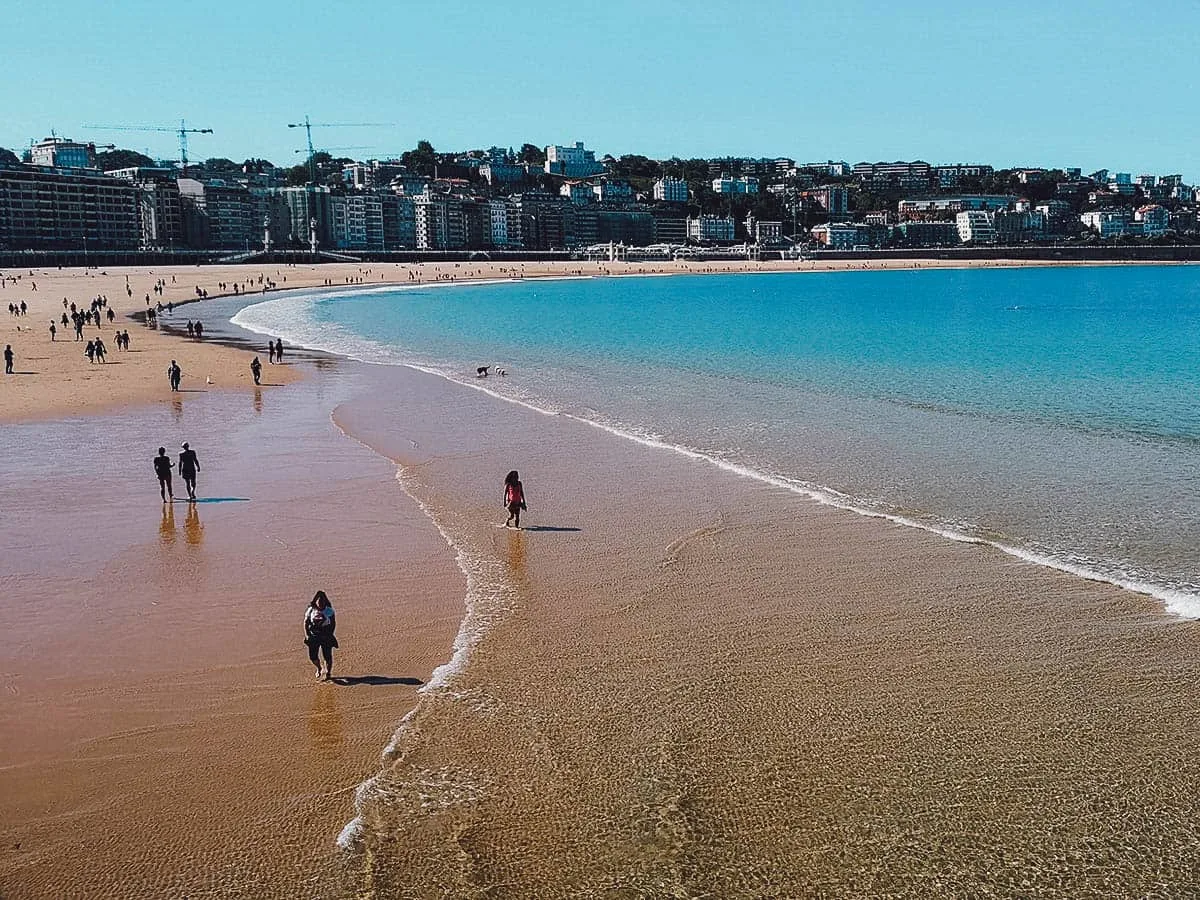
3. Go Hiking on Mount Urgull
If you like hikes and panoramic views, then you’ll enjoy the walk up to the top of Mount Urgull. It’s a hill behind the San Telmo Museum topped by a 12th century castle and a 12-meter (39.4 ft) high statue of Jesus Christ.
Mount Urgull served as a strategic defense point in previous centuries with Mota Castle being the hill’s military stronghold. Perched on the hill’s summit (123 meters, 403.5 ft), the castle features the most spectacular views of the city and bay along with a small museum detailing the city’s history.
It takes just 30 minutes to walk up to the castle but you’ll want to spend more time exploring Urgull. It’s home to an English cemetery and a lovely seaside promenade that encircles the hill.
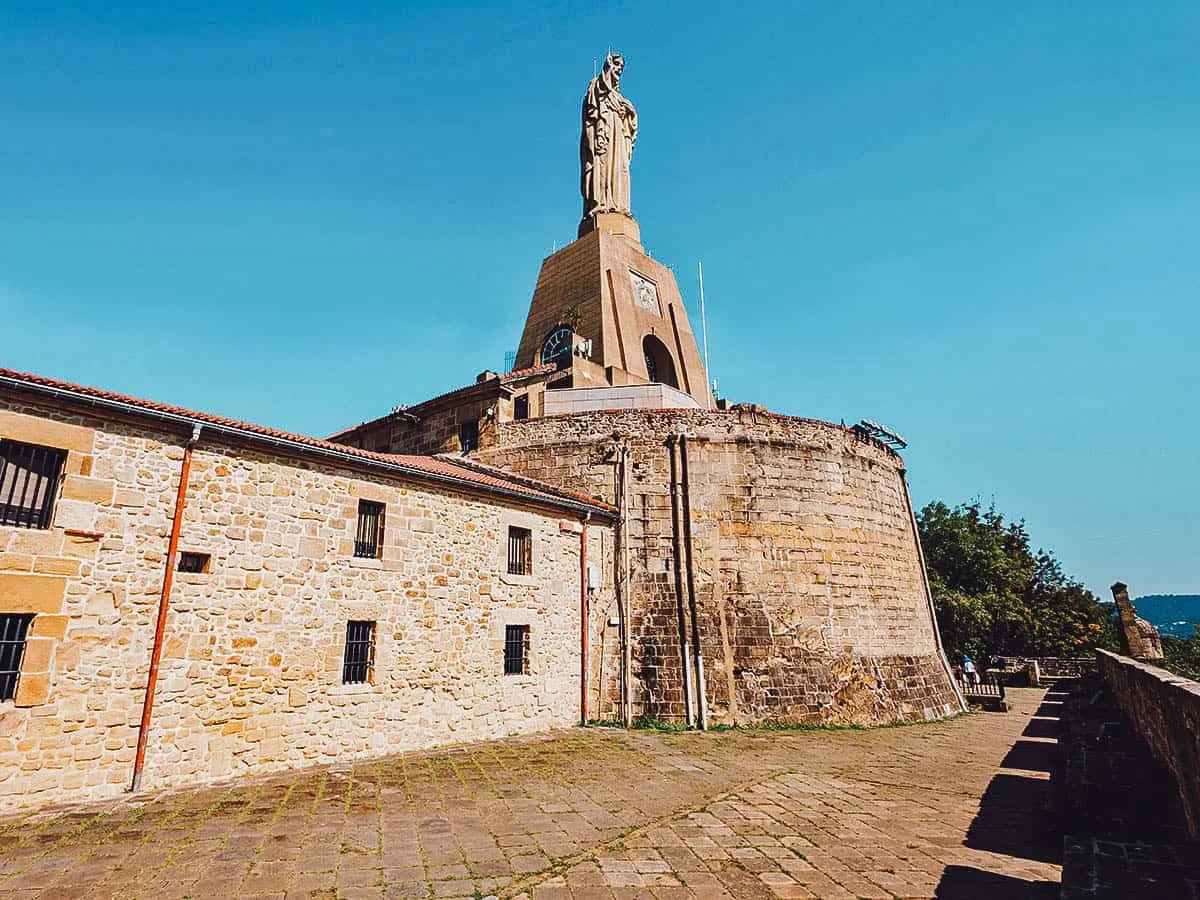
Photo by saiko3p via Shutterstock
Operating Hours: 8AM-9PM (May-Sept), 8AM-7:30PM (Oct-Apr)
Admission: FREE
4. Ride a Wooden Roller Coaster on Mount Igueldo
If you enjoyed the views from Mount Urgull, then you may want to visit Mount Igueldo as well. It’s a hill located on the western side of La Concha Beach.
Accessible via funicular, Mount Igueldo’s summit is higher than Urgull (181 meters, 593.8 ft) and offers equally breathtaking views. Curiously, it’s home to a small amusement park that features old-fashioned rides like carousels and bumper cars, even a wooden roller coaster!
You can refer to the Monte Igueldo website for more information on park opening hours and prices.
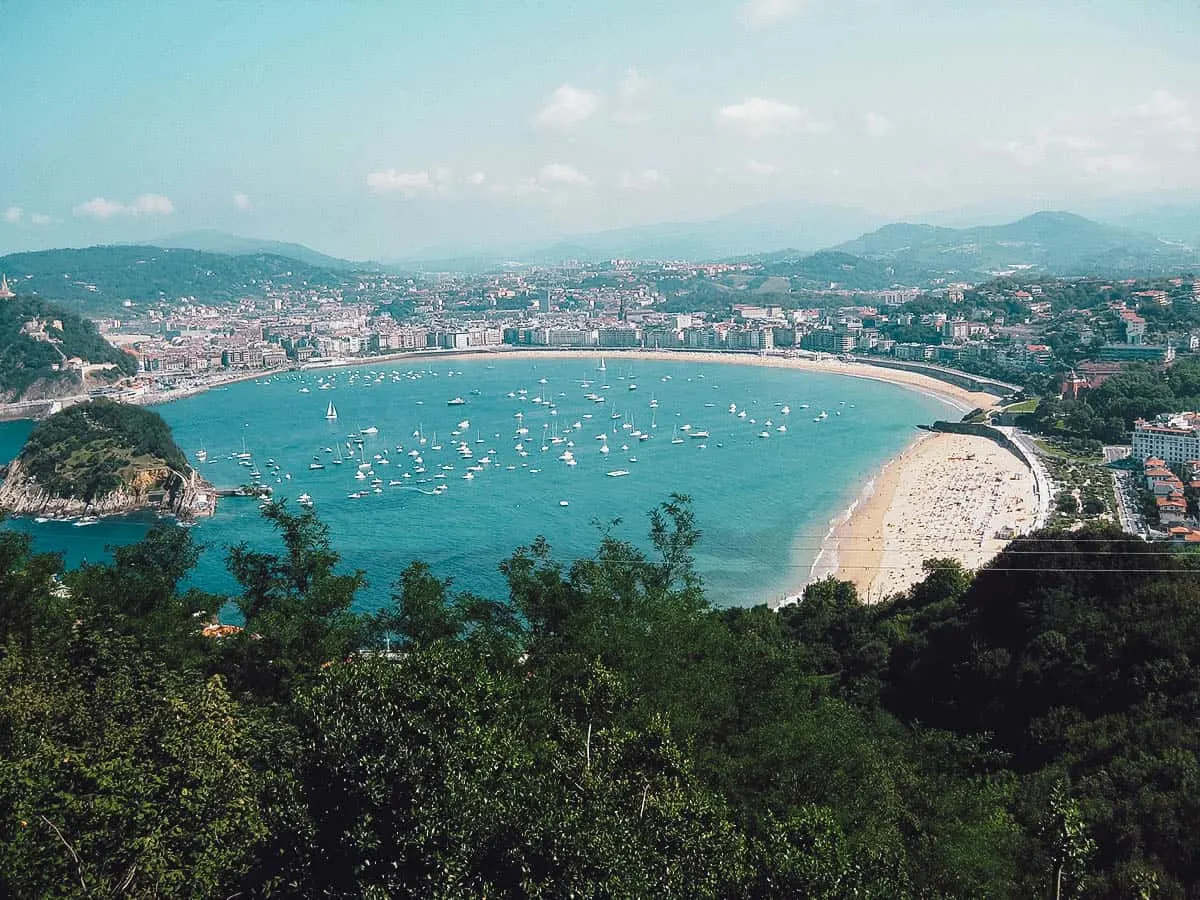
“San Sebastian desde Igueldo” by Spanish Coches, used under CC BY 2.0 / Cropped, processed in Photoshop and Lightroom
5. Take a Cooking Class
We love taking cooking classes when we travel. Food tours are great for finding local restaurants but if you really want to learn about a foreign cuisine, then the best thing you can do is to take a cooking class. It’s like looking under the cuisine’s hood.
We didn’t take one in San Sebastian but there are a few you can choose from on Cookly. Click on the link for a list of cooking class in San Sebastian.
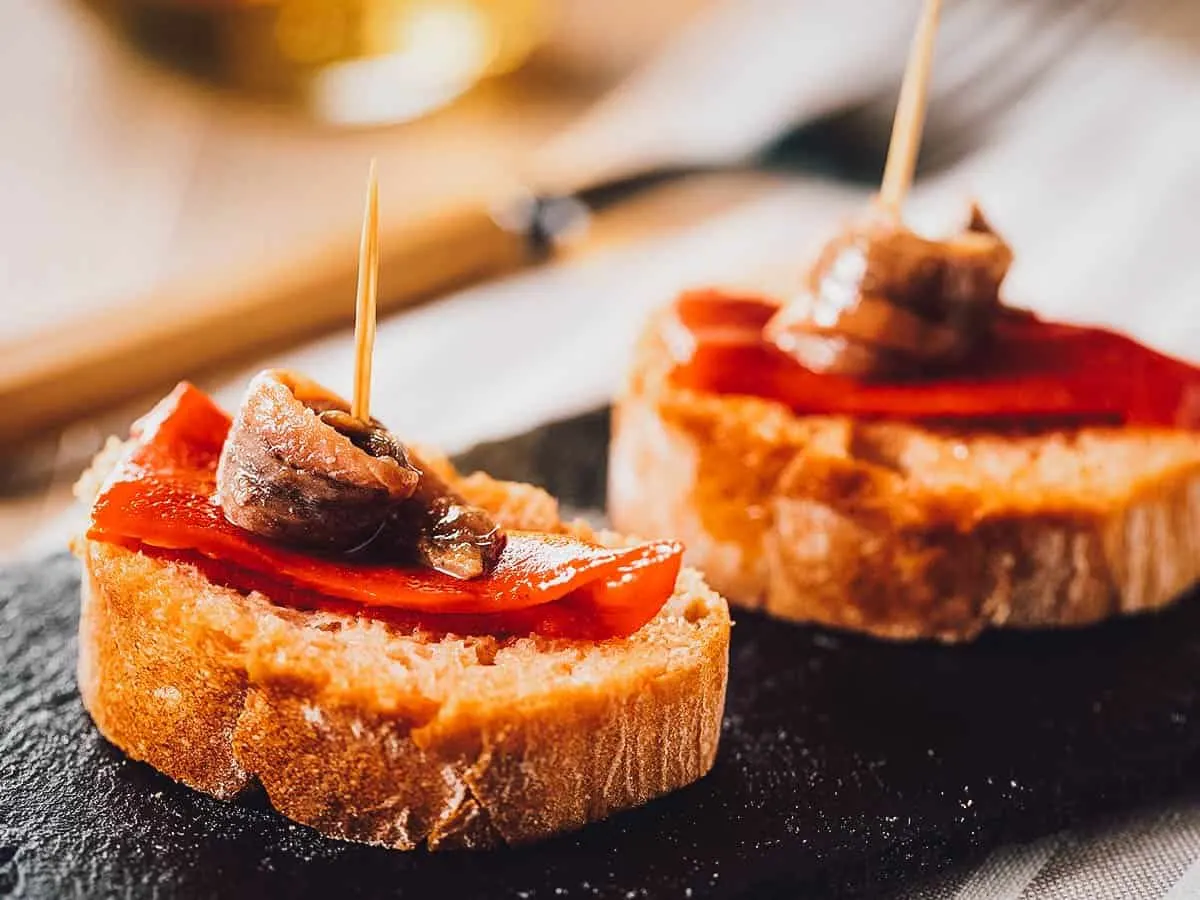
Photo by funkyfrogstock via Shutterstock
DAY TRIPS FROM SAN SEBASTIAN
1. Getaria
Getaria has long been known as the hometown of Juan Sebastian Elcano, a seaman credited for being the first to circumnavigate the globe. But these days, it’s perhaps better known for its gastronomy. Specifically, for its Basque-style grilled turbot and Txacoli wine.
The Basque-style of grilling fish involves cooking a whole fish in a specially designed metal basket called a besuguera. They follow a certain procedure to cook the turbot which two people, including my brother, have described as the best fish they’ve ever tasted in their lives. It’s customarily paired with Txakoli wine which is a slightly sparkling, highly acidic dry white wine.
Unfortunately, we didn’t get to try this heavenly pairing ourselves but it’s a mistake we won’t be making again on our next trip to the Basque region.
Getaria is located less than 30 km (18.6 miles) west of San Sebastian. The UK10 or UK11 buses will get you there in less than 40 minutes, or you can go on a Txacoli wine-tasting tour.
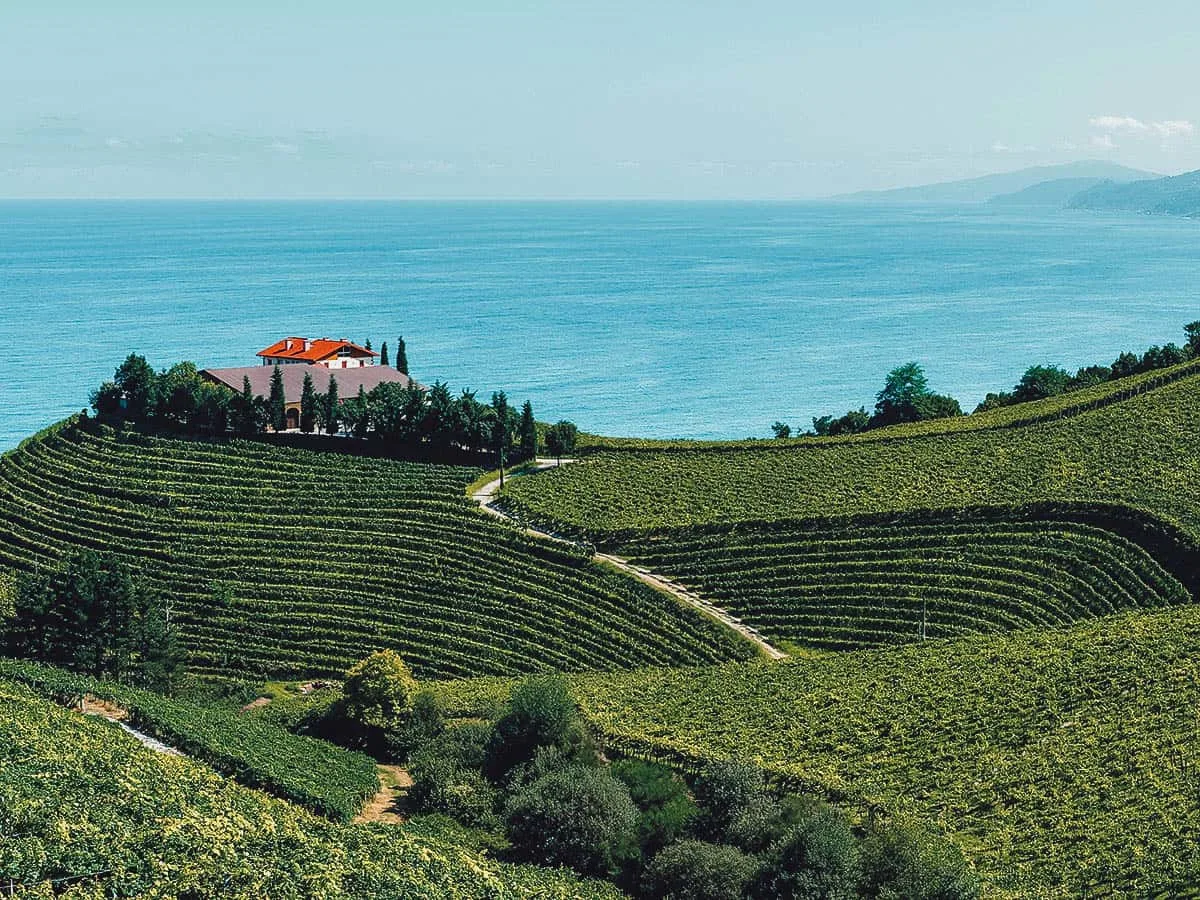
Photo by Alberto Loyo via Shutterstock
2. Hondarribia
Hondarribia is a charming fishing village about 23 km (14.3 miles) east of San Sebastian. Located on the Bay of Txingudi along the French border, it’s been described as one of the most beautiful towns in the Basque Country.
Like Getaria and Logroño, it’s become known in recent years for its gastronomy. Many young chefs have set up shop in Hondarribia to create a budding culinary landscape that rivals its more famous neighbors.
You can get to Hondarribia by E20 bus from San Sebastian in less than 40 minutes. Alternatively, you can also go on a guided tour.
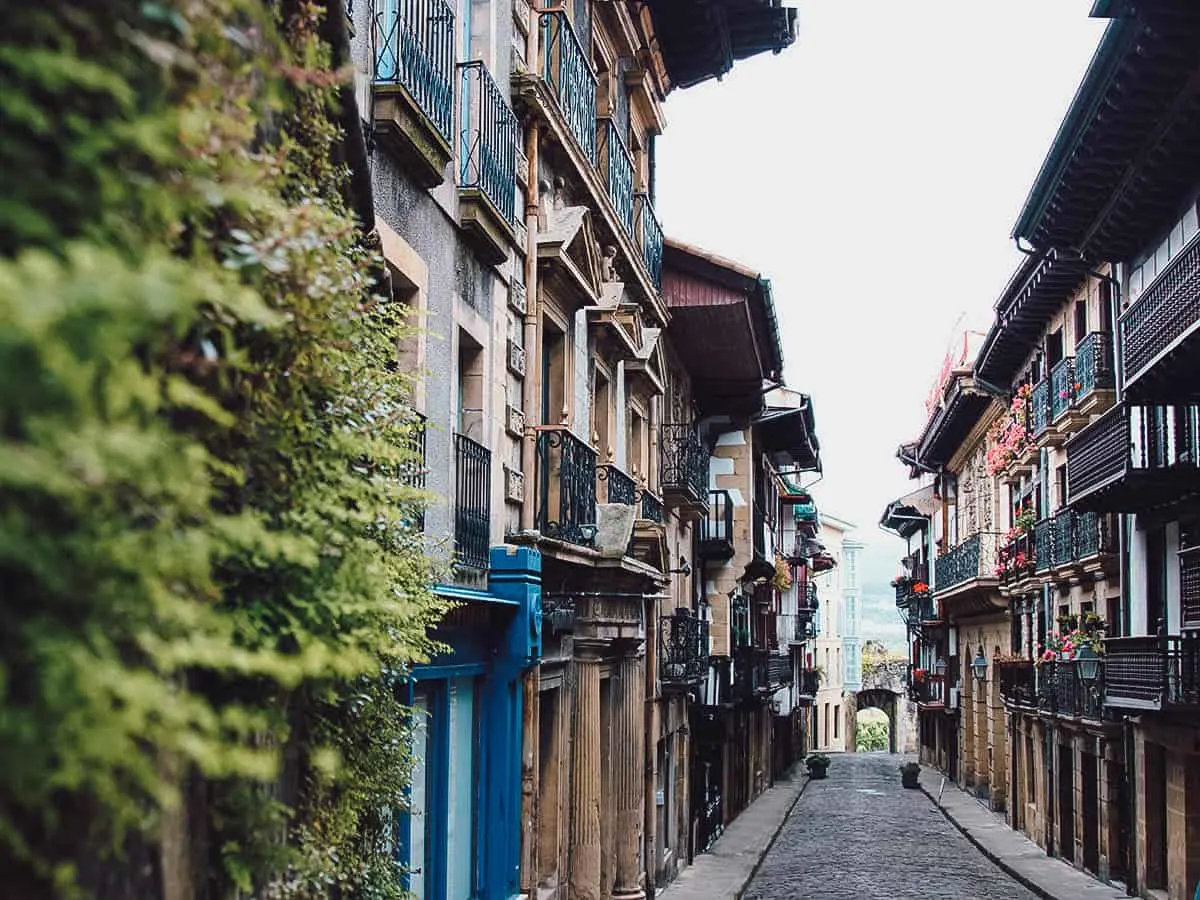
Photo by carballo via Shutterstock
3. Bilbao
Bilbao was the first stop we made on our drive from San Sebastian to Santiago de Compostela. It’s the biggest city in the Basque Country and recognized as a hub for art, design, architecture, and gastronomy.
The spectacular Guggenheim Museum is the city’s most famous attraction but it’s hardly the only place of interest in Bilbao. You could easily spend the entire day exploring this city!
Other than the Guggenheim, much of your time will be spent at Casco Viejo which is Bilbao’s version of the Parte Vieja. It’s a fascinating network of narrow winding streets that’s home to churches, museums, restaurants, and Europe’s biggest indoor market – La Ribera Market.
Other points of interest include the Plaza Nueva, the Museo Bellas Artes, and the Azkuna Zentroa – a wine storage warehouse that was redesigned into a cultural center by renowned designer Philippe Starck.
Bilbao is over 100 km (62 miles) west of San Sebastian. You can get there by bus in about 1 hr 15 minutes. It’s possible to go by train as well but the journey is twice as long. If you’d like to go on a guided tour, then you can book one through Get Your Guide (Option 1 | Option 2).
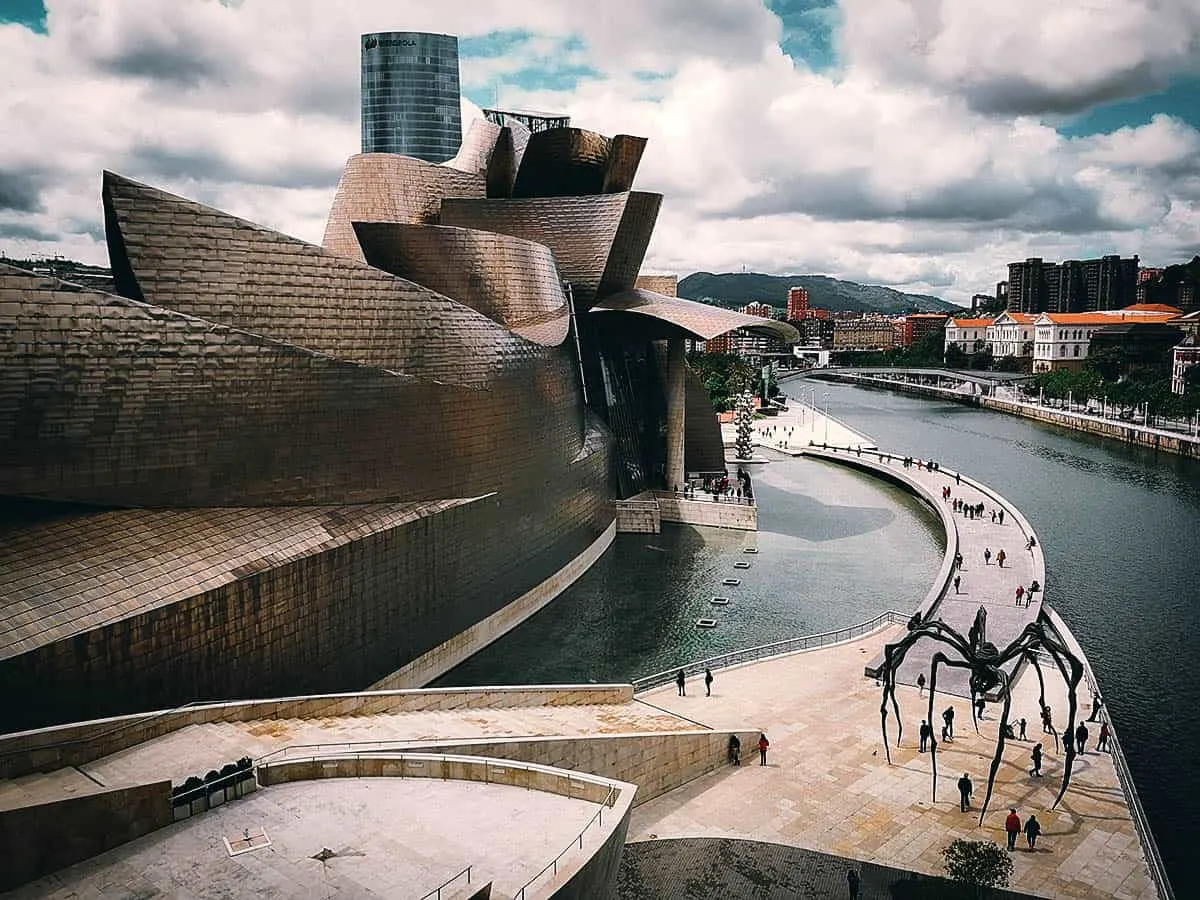
4. French Basque Country
The term Basque Country refers to the home of the Basque people. It’s an area of land that straddles the border between Spain and France.
The region in Spain is officially known as the Basque Autonomous Community, but people often refer to it simply as “Basque Country”. The region in France is known as the Pays Basque or the French Basque Country.
We didn’t get to visit the Pays Basque but it may be interesting to experience the French side of the Basque Country. Smaller in area than its Spanish counterpart, the French Basque Country is comprised of three territories – Labourd, Lower Navarre, and Soule – with two of its most notable towns being Biarritz and Bayonne.
If you’d like to explore the French Basque Country, then you can do so by renting a car or going on a guided tour (Option 1 | Option 2).
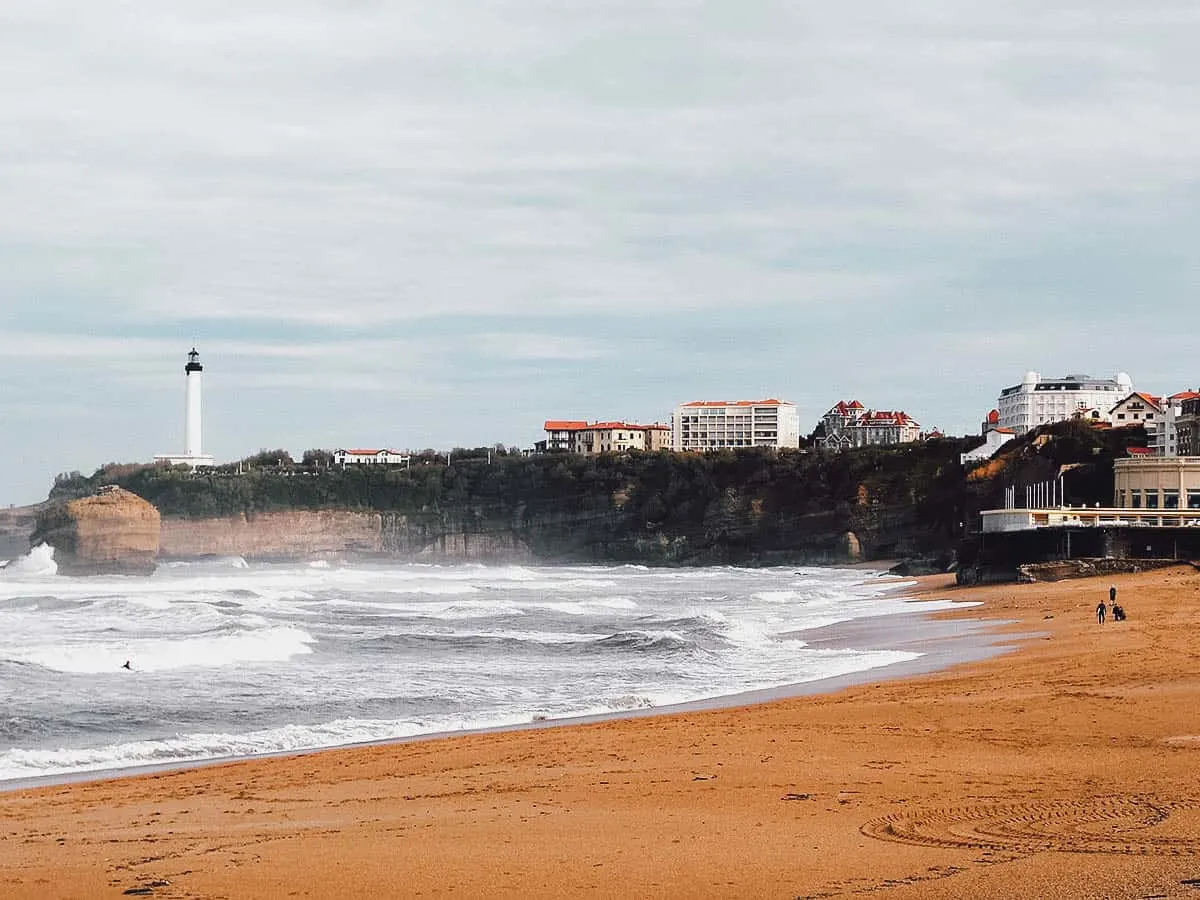
“Biarritz” by Sebastien Bertrand, used under CC BY 2.0 / Cropped, processed in Photoshop and Lightroom
5. Logroño
If you’re visiting San Sebastian mainly for the pintxos, then you’ll want to take a day trip to Logroño. It’s the capital city of La Rioja province and described by some as having the best pintxos in the region. We agree.
We rented a car and made the 2-hour drive to Logroño. We did a pintxos crawl and visited eight of the best pintxos bars along Calle del Laurel. Unlike bars in San Sebastian that offer both hot and pre-made pintxos, nearly every bar we went to in Logroño makes them fresh to order.
Everything we had was delicious but the cremini mushroom and shrimp pintxos are definitely the star. Check out our food guide for recommendations on the best pintxos bars in Logroño.
Logroño is over 160 km (99.4 miles) south of San Sebastian. You can go by La Estrella bus (over 2 hrs each way) but renting a car and driving on your own would be better.
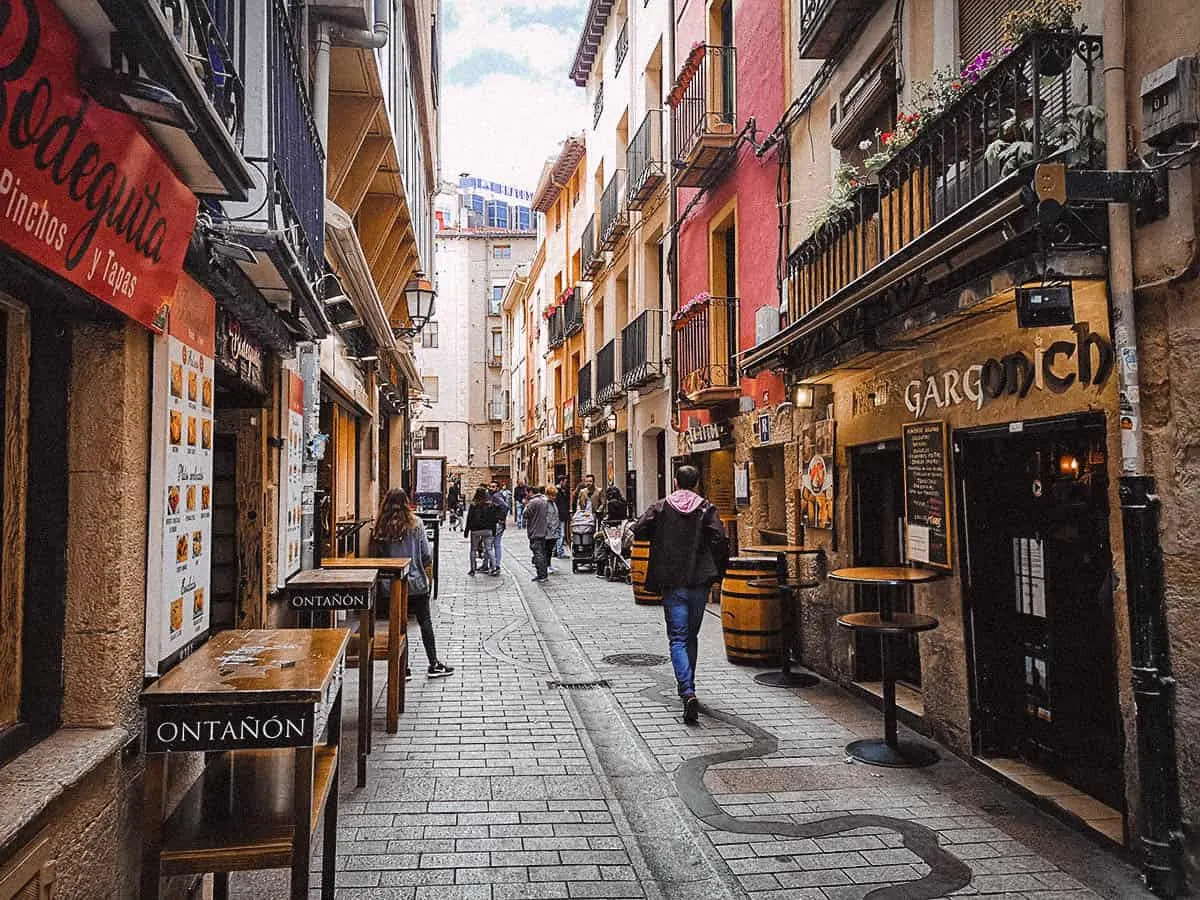
SPANISH FOOD GUIDE
In my opinion, Spain is one of the world’s best countries for food. It’s home to many delicious dishes like paella valenciana, tapas, pintxos, callos a la madrileña, and churros.
If you’re wondering what to eat in San Sebastian, then check out our Spanish food guide for a list of 45 of the most delicious dishes in Spain. If you like tapas as much as we do, then be sure to check out our Spanish tapas guide as well.
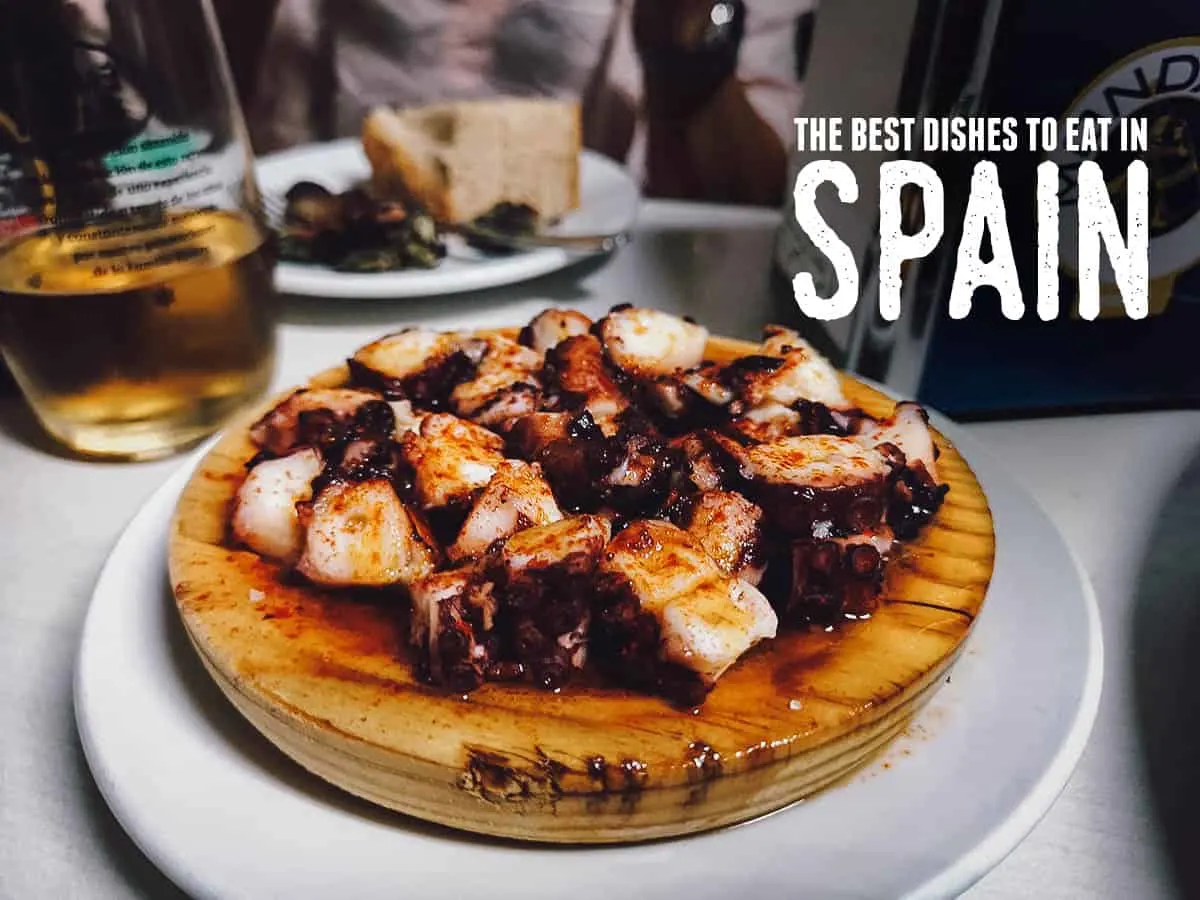
SPANISH DESSERTS
Spanish savory dishes like paella and callos are delicious but so are Spanish desserts. You’ve probably heard of popular desserts like churros con chocolate and crema catalana but check out our article on Spanish desserts for more sweet recommendations in Spain.
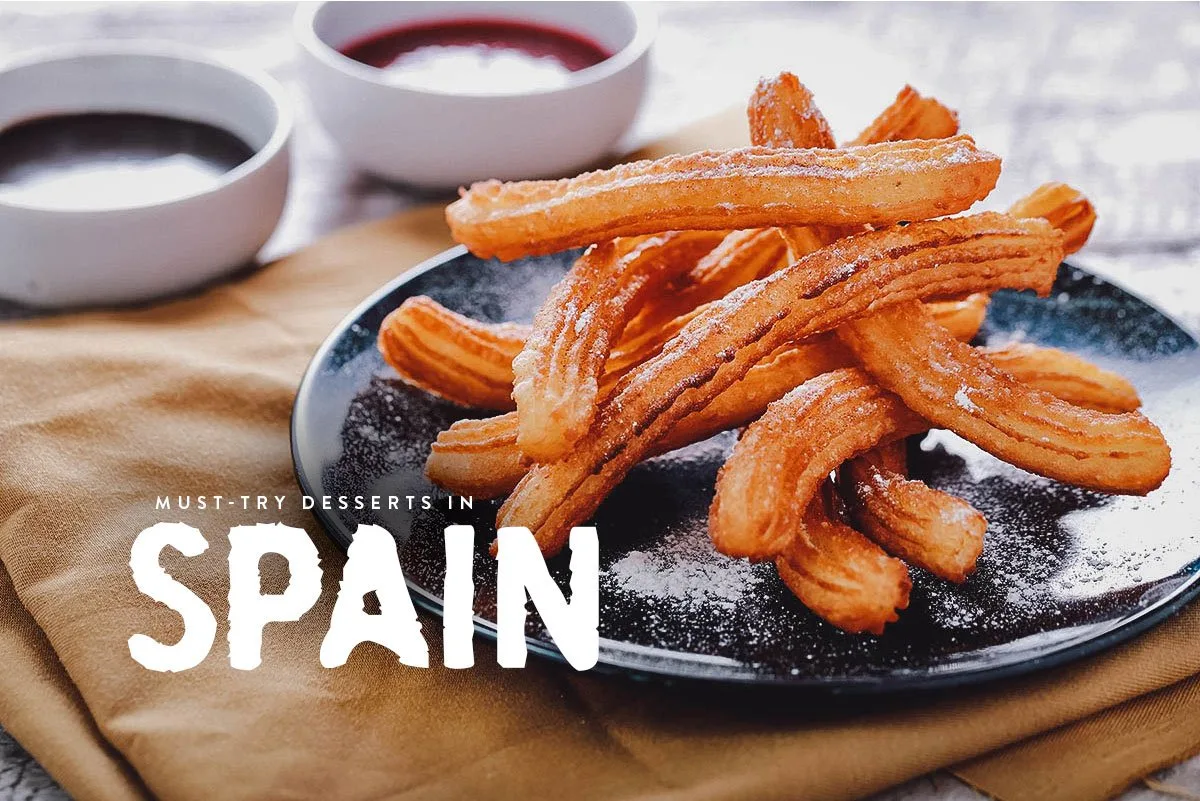
WHERE TO EAT IN SAN SEBASTIAN
As beautiful a city as San Sebastian is, we were there mainly to eat. Chances are, you’re going for the same reasons so check out our food guide for some of the best pintxos restaurants in San Sebastian.
If you’ve never had them, pintxos refers to a family of small bar snacks. They’re similar to tapas except they’re typically skewered onto a piece of bread to hold the ingredients in place.
It’s easy enough to go pintxos bar hopping on your own, but if you’d like to go on a guided pintxos food tour with a local, the you can book one through Get Your Guide.
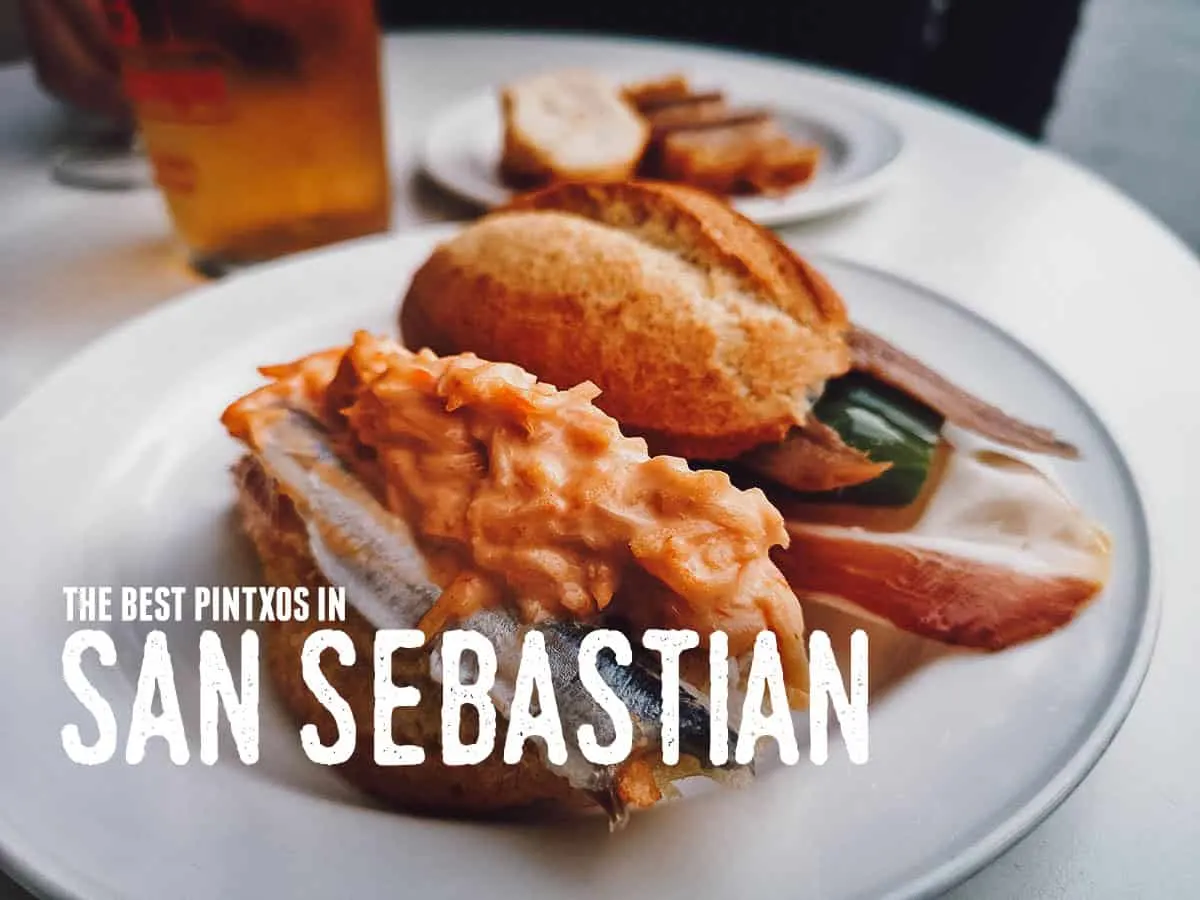
Ten restaurants may be too many for some people so I’ve listed four of our favorites below. Be sure to click through to the complete food guide for more pictures and information.
1. Taberna Dakara Bi – CLOSED
Taberna Dakara Bi was the first pintxos bar we went to in San Sebastian. We were drawn to their solomillo con foie or sirloin steak with foie gras pintxos, which some reviewers described as being some of the best in the city. They may be right.
As you can see below, they take a hefty slice of perfectly cooked juicy steak and top it with a generous amount of seared foie gras. This was seriously delicious and one of the best pintxos we had in the Basque Country.
Don’t forget to try their foie a la plancha as well which is served with an even bigger hunk of foie gras. You can see it behind the solomillo con foie below.
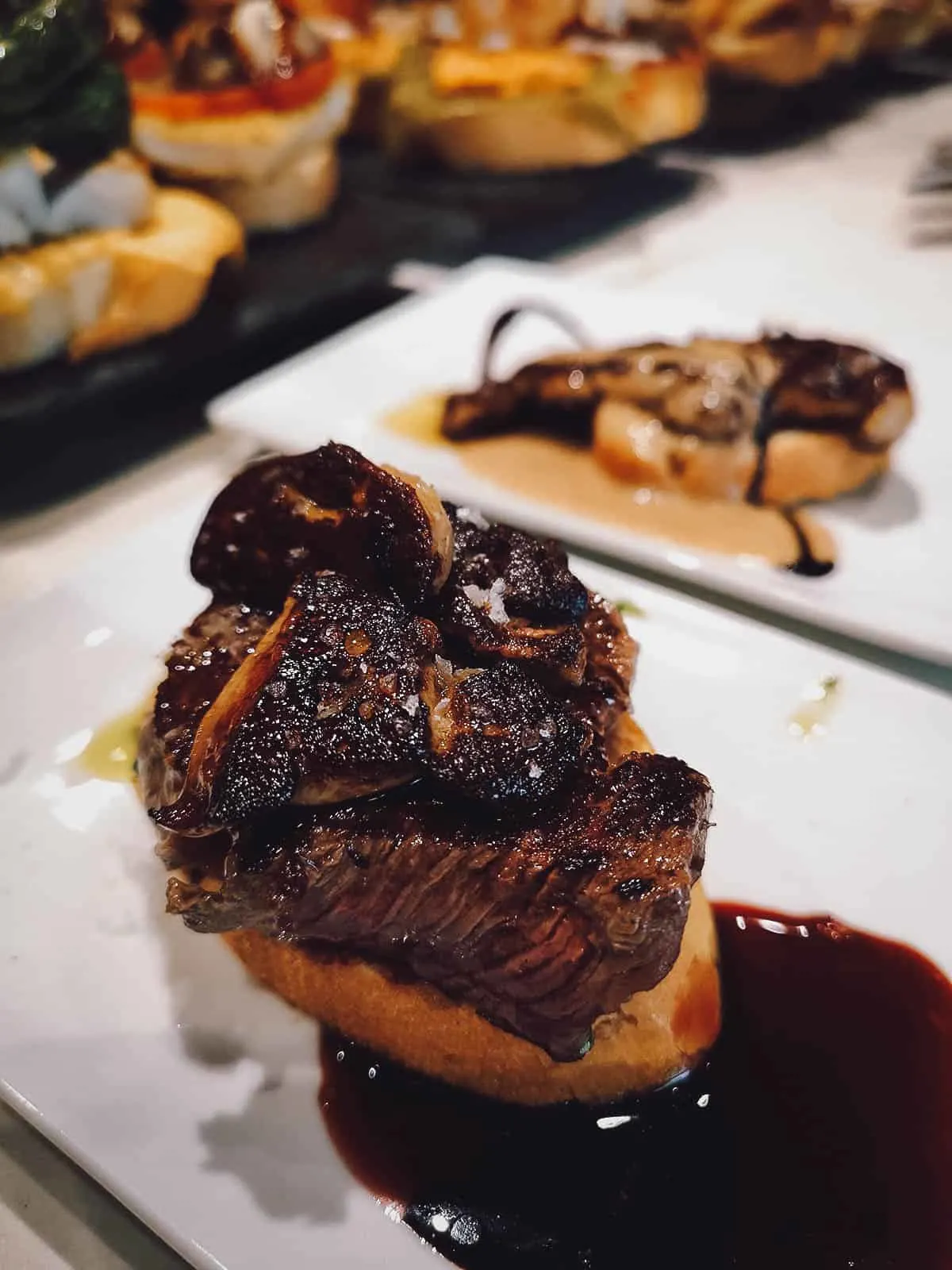
2. Bar Gorriti
As much as possible, I try to seek out local favorites when we travel. Bar Gorriti seemed to be one of the more local pintxos bars I could find in the Old Town. Unlike some places that seemed to cater to tourists, Bar Gorriti felt like the real deal.
Bar Gorriti offers a good range of delicious pintxos and mini bocadillos which are traditional Spanish sandwiches.
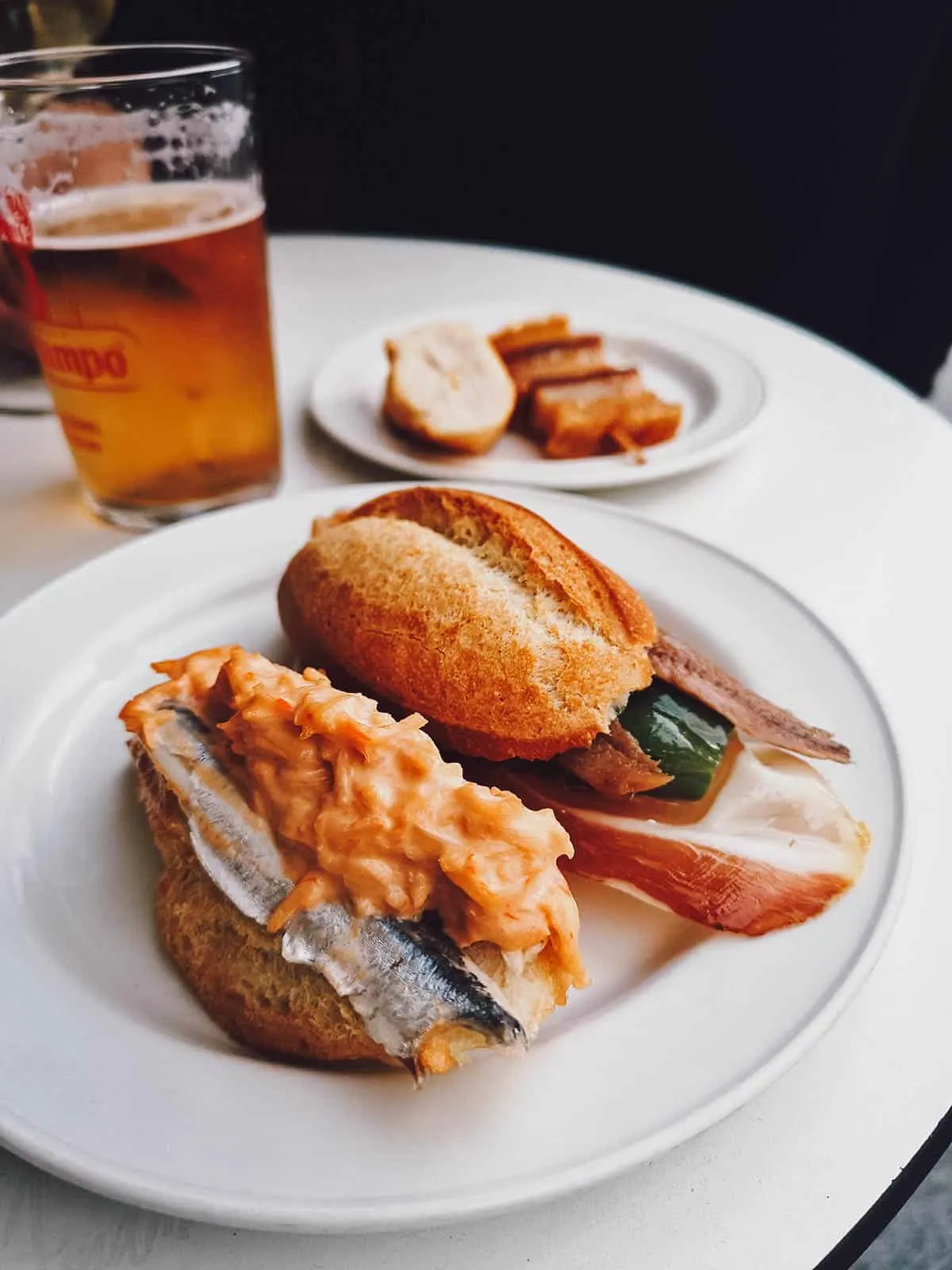
3. La Cuchara de San Telmo
La Cuchara de San Telmo is one of the most popular restaurants in San Sebastian. I don’t think they serve pintxos but they do offer many delicious tapas dishes like this cochinillo asado or roast suckling pig.
Located next to the San Telmo Museum, La Cuchara is always crowded so it’s best to come early if you can.
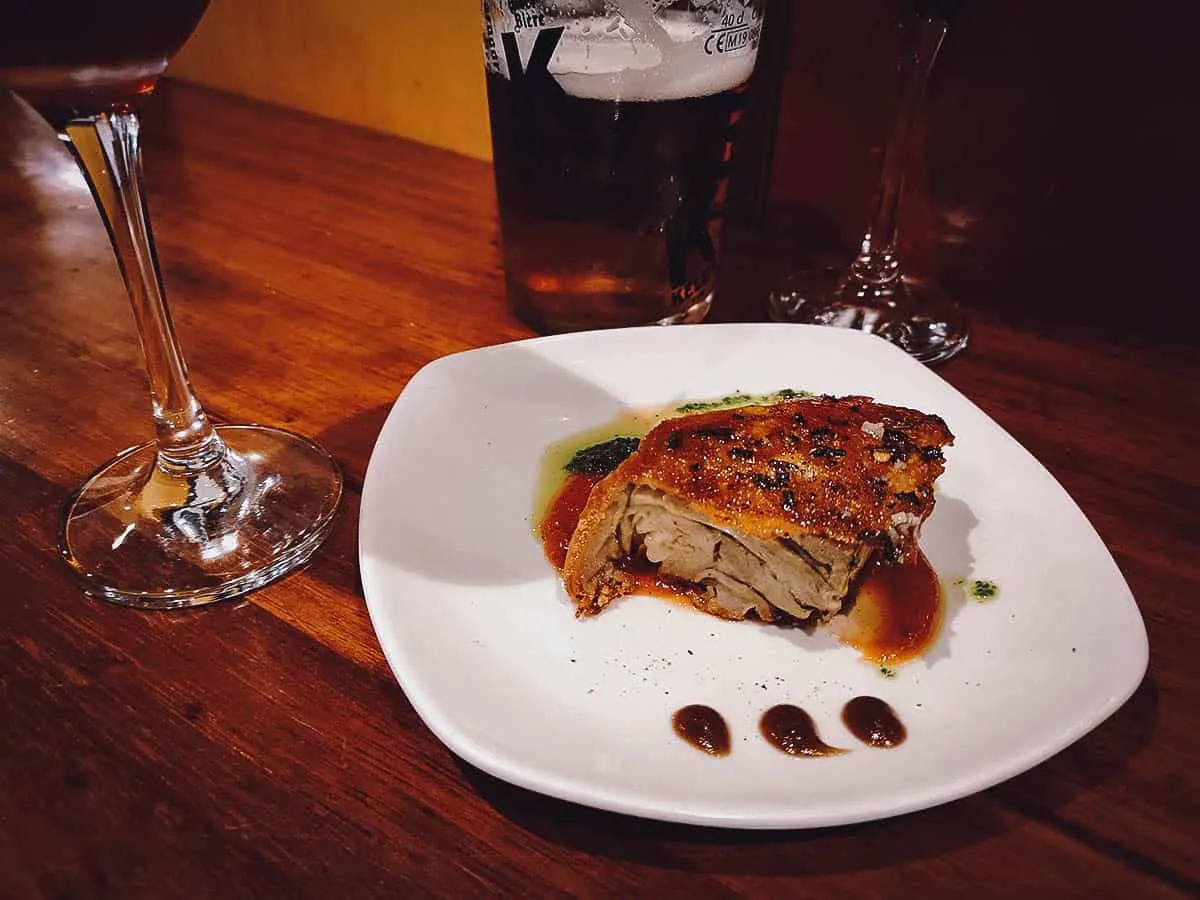
4. Gandarias Jatetxea
Gandarias Jatetxea is another extremely popular restaurant in the Old Town. It consists of two sections – a standing room only pintxos bar and a sitdown restaurant for more formal meals.
We enjoyed many delicious pintxos at Gandarias but one of our favorites was this brocheta de cordero or lamb brochette. Delicioso!
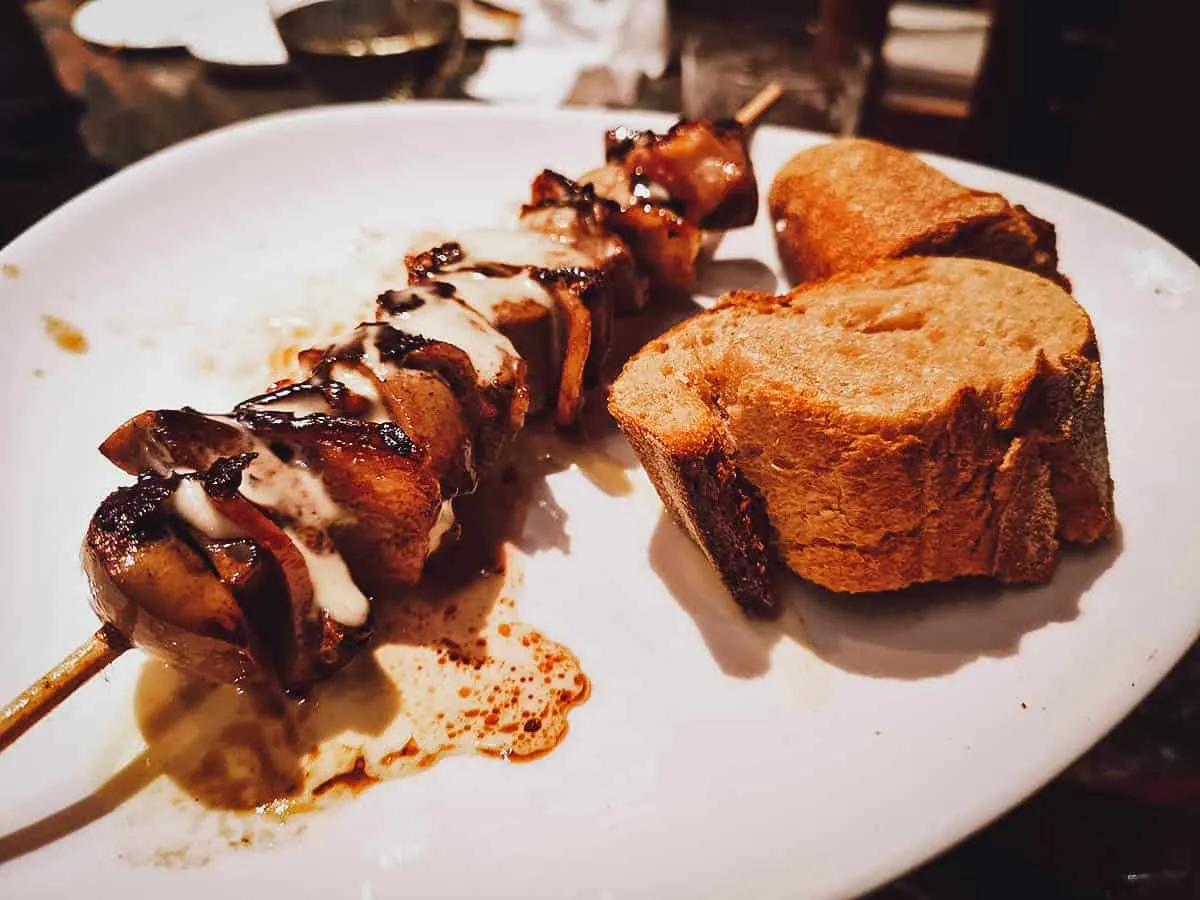
POINTS OF INTEREST IN SAN SEBASTIAN
To help you navigate, I’ve pinned the places recommended in this guide on a map. Click on the link to open the interactive map in a new window.
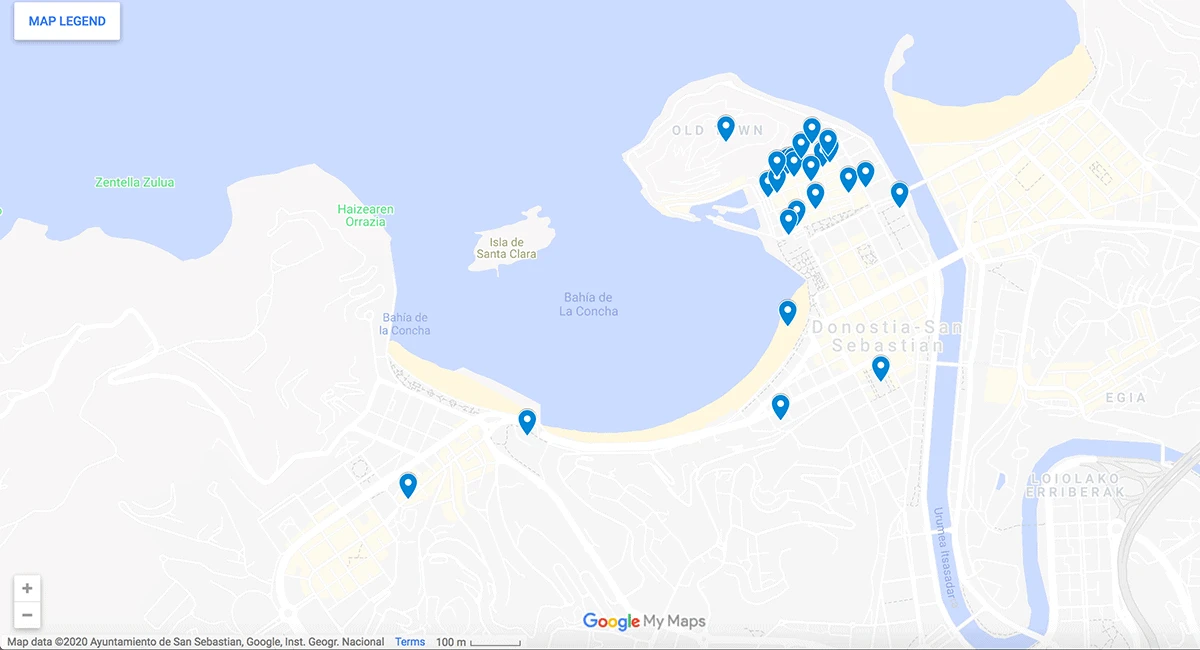
HOW TO GET AROUND IN SAN SEBASTIAN
San Sebastian isn’t that big, but it’s big enough that it may make getting around on foot difficult for some people. Personally, I enjoy walking but some travelers may need to use public transportation.
If you plan on taking public transportation, then be sure to have a reliable wifi connection and the Google Maps app (iOS | Android) installed on your smartphone. It’ll tell you all the different ways to get from point A to point B using public transportation like the Dbus, which is San Sebastian’s local bus service.
The standard fare on the Dbus is EUR 1.85 per journey. I never had to take the bus but based on what I’ve read, drivers can usually offer change for bills no larger than EUR 20 so bring small change if you can.
If you’re staying long enough and need to ride the bus often, then you may be interested in getting a tourist card like the San Sebastian Card, Basque Card, or Mugi Card.
HOW MANY DAYS TO STAY / SAN SEBASTIAN ITINERARY
As described, San Sebastian isn’t that big and its top attractions are clustered within a relatively small area. If you rush, then you can probably cover everything in one day.
But why would you want to? San Sebastian is a relaxed beach town with great atmosphere and food so it’s best to slow down and enjoy it. There are plenty of interesting day trips you can make so if you have the time, then I think three full days is ideal. At the very least, shoot for two.
Here’s a sample 3D/3N San Sebastian itinerary to help you plan your trip.
| DAY ONE • Good Shepherd of San Sebastian Cathedral • Victoria Eugenia Theater • San Sebastian City Hall • Basilica de Santa Maria del Coro • San Telmo Museum • Iglesia de San Vicente • Plaza de la Constitucion • Pintxos bar crawl |
| DAY TWO • Mount Urgull • San Sebastian Aquarium • La Concha Beach • Miramar Palace • Ondarreta Beach • Comb of the Wind • Mount Igueldo • Sidreria |
| DAY THREE • Day trip |
SAN SEBASTIAN TRAVEL TIPS
1. Plan your Trip with Sygic Travel
If you enjoy planning every little detail of your trips like I do, then you may find the Sygic Travel app useful. I’ve been using this free trip planning app for many years now. It allows me to pin points of interest on a map then group them together by location to come up with as efficient an itinerary as possible. You can download it for free on iOS or Android.
2. Rent a Pocket Wifi Device
Having a strong and steady wifi connection is so important these days, especially when traveling in a country with a language barrier. You’ll need it to navigate, translate, and google “best foie a la plancha in san sebastian”. Having access to Google Maps alone justifies the cost.
We brought our own Pokefi devices so we didn’t need to rent any in Europe. But if you do need a mobile router that works in Spain, then you can rent one through Get Your Guide. You can have it delivered to your hotel in Barcelona or Madrid.
3. Check for San Sebastian Travel Deals
I use several websites to book tours and other travel-related services. For destinations in Spain and Europe, the site I use the most is Get Your Guide. They offer the biggest selection of deals on tours, show tickets, tourist cards, and more.
4. Rent a Car
Renting a car is one of the best ways to experience Spain and Europe. It gives you the freedom to travel at your own pace and not be a slave to train and bus schedules.
We wanted to drive across northern Spain so we rented a car in San Sebastian and drove it all the way to Santiago de Compostela. Thanks to our rental car, we got to explore several towns along the way like Bilbao, Comillas, Oviedo, and Lugo. You can rent a car in Spain through Rentalcars.com.
5. Get Travel Insurance
Whether or not to get travel insurance is something we deliberate upon before every trip. If we plan on doing any physical activities that could get us injured like bike riding or extreme pintxos eating, then we’ll definitely get it.
When we do feel the need for insurance, we get it from SafetyWing or Heymondo. They’re popular travel insurance companies used by many long-term travelers. Click on the links to get a free quote from SafetyWing or Heymondo. Will Fly for Food readers get 5% off on Heymondo when picking up a policy through our link.
6. Bring the Right Power Adapter
Spain has Type C or Type F electrical outlets so be sure to bring the right power adapters for your devices. Electrical voltage is 230V and the standard frequency is 50Hz.
Have Fun!
I’m hardly an expert on Donostia-San Sebastian but I do hope that you find this guide useful. I’m only sharing the things I learned from our trip. If you have any questions or comments, then please feel free to leave them in the comment section below.
Thanks for reading and have a delicious time stuffing your face with pintxos in San Sebastian!
Disclosure
Some of the links in this San Sebastian travel guide are affiliate links, meaning we’ll earn a small commission if we make a sale at no added cost to you. We only recommend products and services that we use ourselves and firmly believe in. We really appreciate your support as this helps us make more of these free travel guides. Thank you!


Sergio Arregui
Thursday 28th of July 2022
Hi, I'm from San Sebastian and I'd like to suggest a place that is always forgotten about in articles, one of the most beautiful and peaceful spots in Donostia, surrounded by nature and with breathtaking panoramic views: Mount Ulía.
JB & Renée
Friday 29th of July 2022
Thank you for the suggestion Sergio! We're planning on going back to Donostia in 2023. We'll definitely keep that in mind.